PUBH6004: Leadership & Change: Power, Ethics & Values in Public Health
VerifiedAdded on 2023/06/12
|20
|4795
|283
Essay
AI Summary
This essay provides an in-depth analysis of leadership and change management within public health, examining team, agency, and professional levels of leadership. It explores strategies for leading change, facilitating collaboration, and empowerment, while also analyzing the relationships among l...
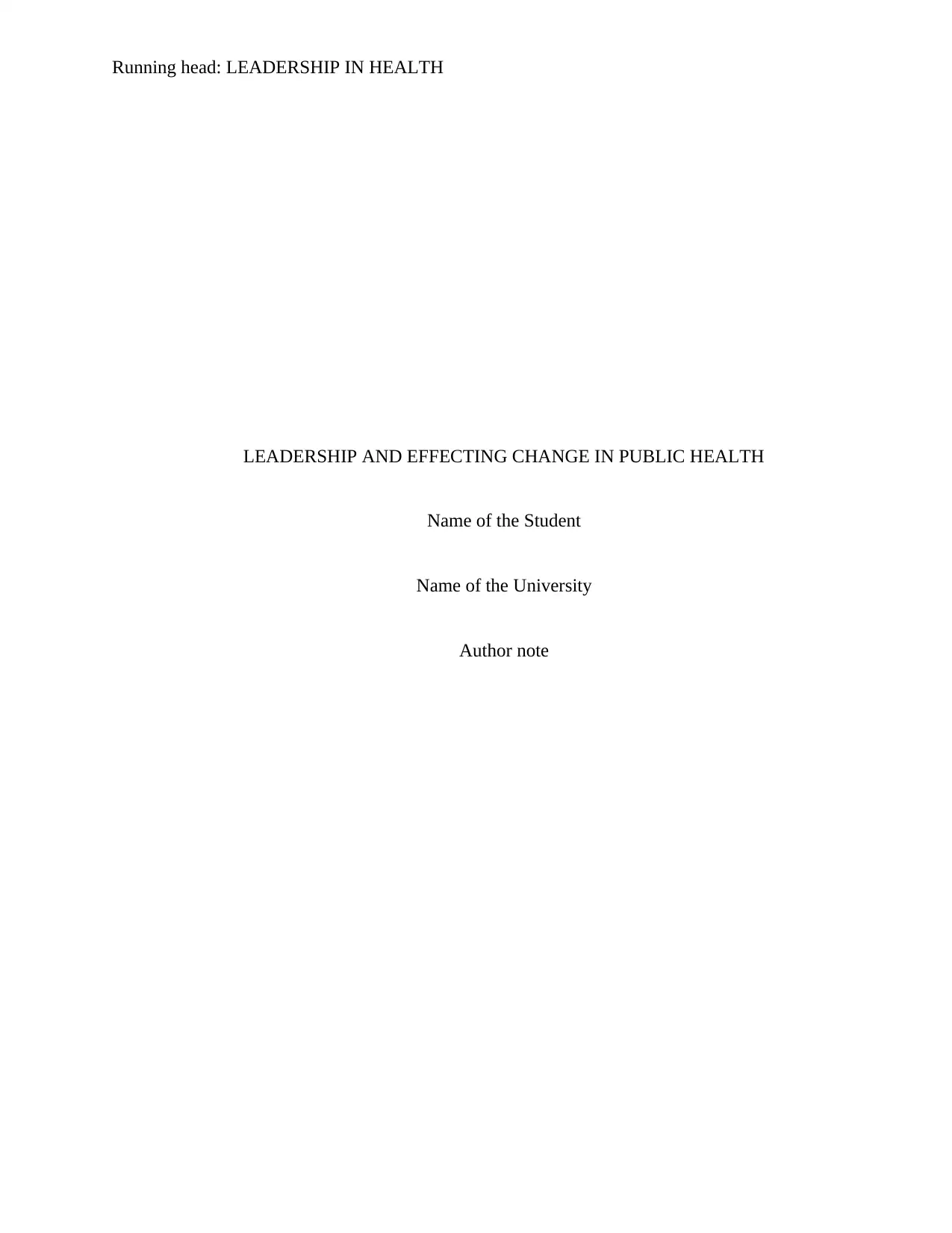
Running head: LEADERSHIP IN HEALTH
LEADERSHIP AND EFFECTING CHANGE IN PUBLIC HEALTH
Name of the Student
Name of the University
Author note
LEADERSHIP AND EFFECTING CHANGE IN PUBLIC HEALTH
Name of the Student
Name of the University
Author note
Paraphrase This Document
Need a fresh take? Get an instant paraphrase of this document with our AI Paraphraser
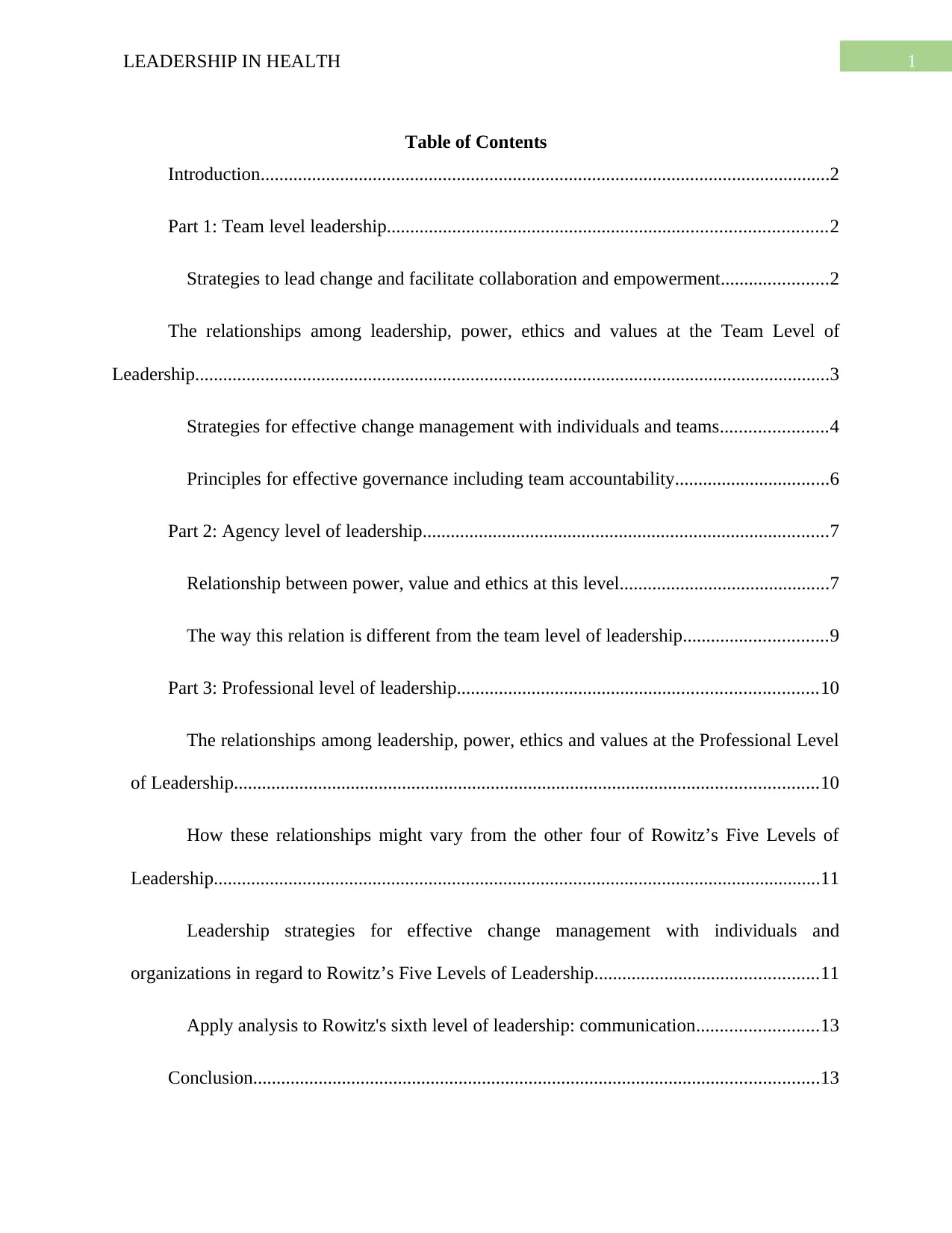
1LEADERSHIP IN HEALTH
Table of Contents
Introduction..........................................................................................................................2
Part 1: Team level leadership..............................................................................................2
Strategies to lead change and facilitate collaboration and empowerment.......................2
The relationships among leadership, power, ethics and values at the Team Level of
Leadership........................................................................................................................................3
Strategies for effective change management with individuals and teams.......................4
Principles for effective governance including team accountability.................................6
Part 2: Agency level of leadership.......................................................................................7
Relationship between power, value and ethics at this level.............................................7
The way this relation is different from the team level of leadership...............................9
Part 3: Professional level of leadership.............................................................................10
The relationships among leadership, power, ethics and values at the Professional Level
of Leadership.............................................................................................................................10
How these relationships might vary from the other four of Rowitz’s Five Levels of
Leadership..................................................................................................................................11
Leadership strategies for effective change management with individuals and
organizations in regard to Rowitz’s Five Levels of Leadership................................................11
Apply analysis to Rowitz's sixth level of leadership: communication..........................13
Conclusion.........................................................................................................................13
Table of Contents
Introduction..........................................................................................................................2
Part 1: Team level leadership..............................................................................................2
Strategies to lead change and facilitate collaboration and empowerment.......................2
The relationships among leadership, power, ethics and values at the Team Level of
Leadership........................................................................................................................................3
Strategies for effective change management with individuals and teams.......................4
Principles for effective governance including team accountability.................................6
Part 2: Agency level of leadership.......................................................................................7
Relationship between power, value and ethics at this level.............................................7
The way this relation is different from the team level of leadership...............................9
Part 3: Professional level of leadership.............................................................................10
The relationships among leadership, power, ethics and values at the Professional Level
of Leadership.............................................................................................................................10
How these relationships might vary from the other four of Rowitz’s Five Levels of
Leadership..................................................................................................................................11
Leadership strategies for effective change management with individuals and
organizations in regard to Rowitz’s Five Levels of Leadership................................................11
Apply analysis to Rowitz's sixth level of leadership: communication..........................13
Conclusion.........................................................................................................................13
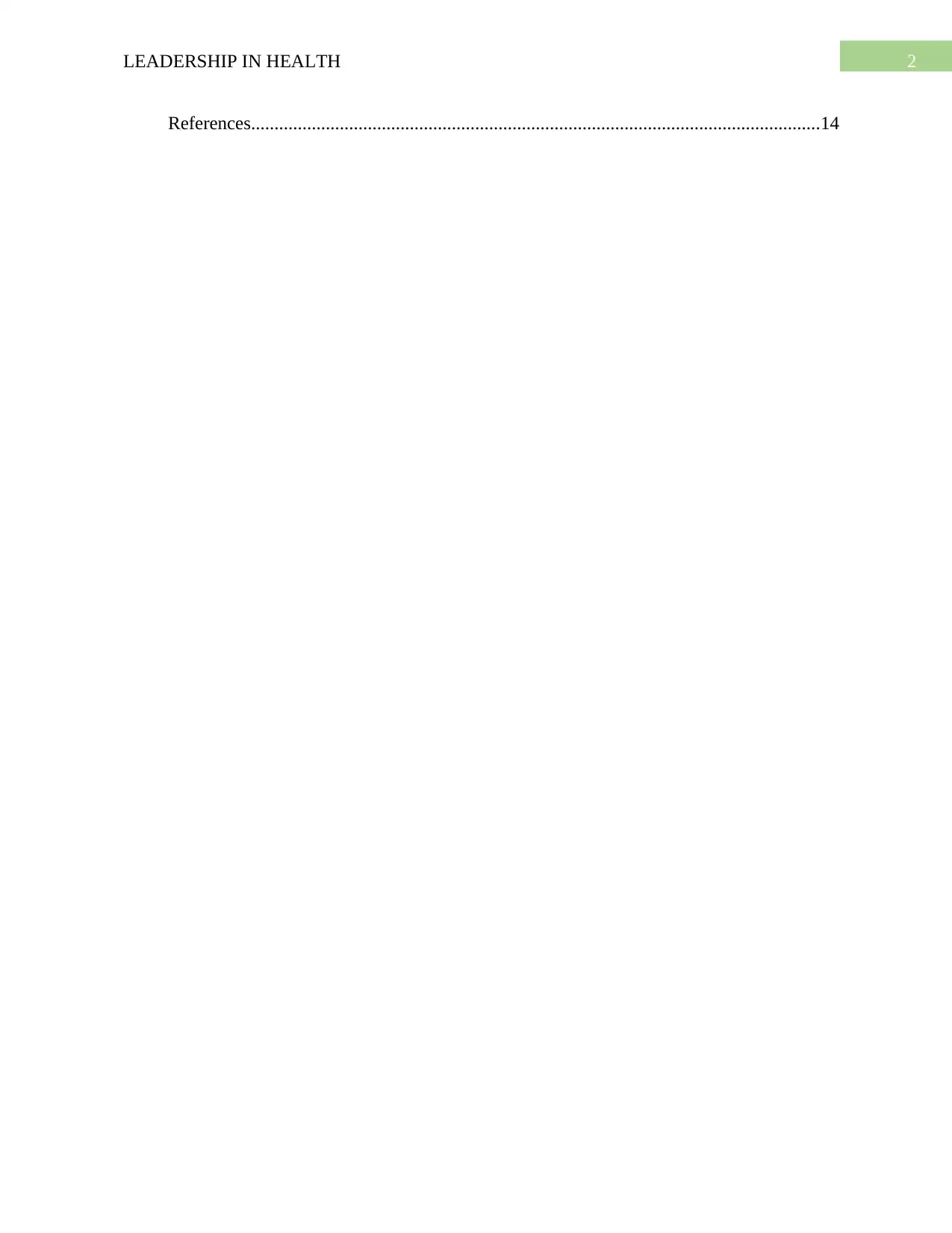
2LEADERSHIP IN HEALTH
References..........................................................................................................................14
References..........................................................................................................................14
You're viewing a preview
Unlock full access by subscribing today!
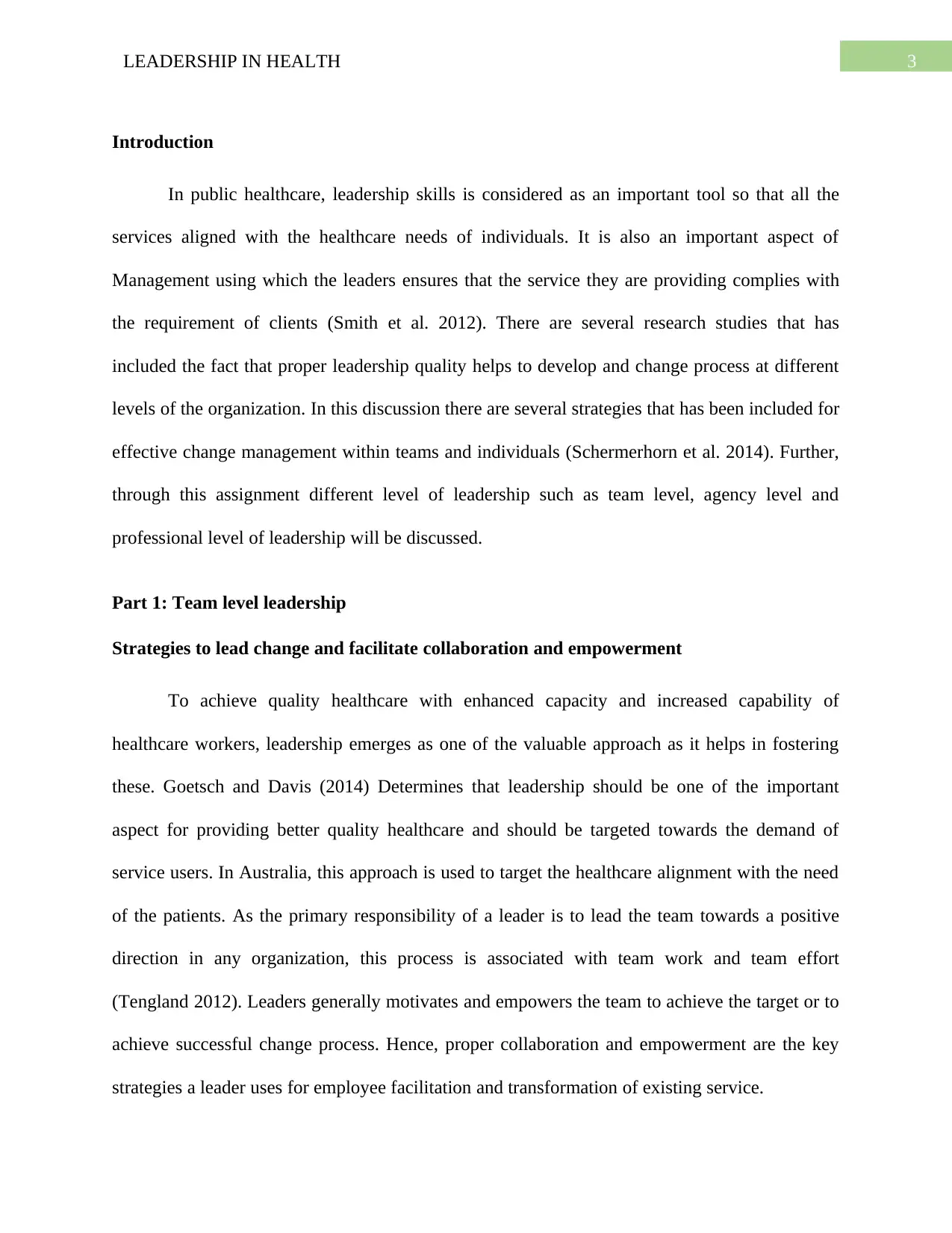
3LEADERSHIP IN HEALTH
Introduction
In public healthcare, leadership skills is considered as an important tool so that all the
services aligned with the healthcare needs of individuals. It is also an important aspect of
Management using which the leaders ensures that the service they are providing complies with
the requirement of clients (Smith et al. 2012). There are several research studies that has
included the fact that proper leadership quality helps to develop and change process at different
levels of the organization. In this discussion there are several strategies that has been included for
effective change management within teams and individuals (Schermerhorn et al. 2014). Further,
through this assignment different level of leadership such as team level, agency level and
professional level of leadership will be discussed.
Part 1: Team level leadership
Strategies to lead change and facilitate collaboration and empowerment
To achieve quality healthcare with enhanced capacity and increased capability of
healthcare workers, leadership emerges as one of the valuable approach as it helps in fostering
these. Goetsch and Davis (2014) Determines that leadership should be one of the important
aspect for providing better quality healthcare and should be targeted towards the demand of
service users. In Australia, this approach is used to target the healthcare alignment with the need
of the patients. As the primary responsibility of a leader is to lead the team towards a positive
direction in any organization, this process is associated with team work and team effort
(Tengland 2012). Leaders generally motivates and empowers the team to achieve the target or to
achieve successful change process. Hence, proper collaboration and empowerment are the key
strategies a leader uses for employee facilitation and transformation of existing service.
Introduction
In public healthcare, leadership skills is considered as an important tool so that all the
services aligned with the healthcare needs of individuals. It is also an important aspect of
Management using which the leaders ensures that the service they are providing complies with
the requirement of clients (Smith et al. 2012). There are several research studies that has
included the fact that proper leadership quality helps to develop and change process at different
levels of the organization. In this discussion there are several strategies that has been included for
effective change management within teams and individuals (Schermerhorn et al. 2014). Further,
through this assignment different level of leadership such as team level, agency level and
professional level of leadership will be discussed.
Part 1: Team level leadership
Strategies to lead change and facilitate collaboration and empowerment
To achieve quality healthcare with enhanced capacity and increased capability of
healthcare workers, leadership emerges as one of the valuable approach as it helps in fostering
these. Goetsch and Davis (2014) Determines that leadership should be one of the important
aspect for providing better quality healthcare and should be targeted towards the demand of
service users. In Australia, this approach is used to target the healthcare alignment with the need
of the patients. As the primary responsibility of a leader is to lead the team towards a positive
direction in any organization, this process is associated with team work and team effort
(Tengland 2012). Leaders generally motivates and empowers the team to achieve the target or to
achieve successful change process. Hence, proper collaboration and empowerment are the key
strategies a leader uses for employee facilitation and transformation of existing service.
Paraphrase This Document
Need a fresh take? Get an instant paraphrase of this document with our AI Paraphraser
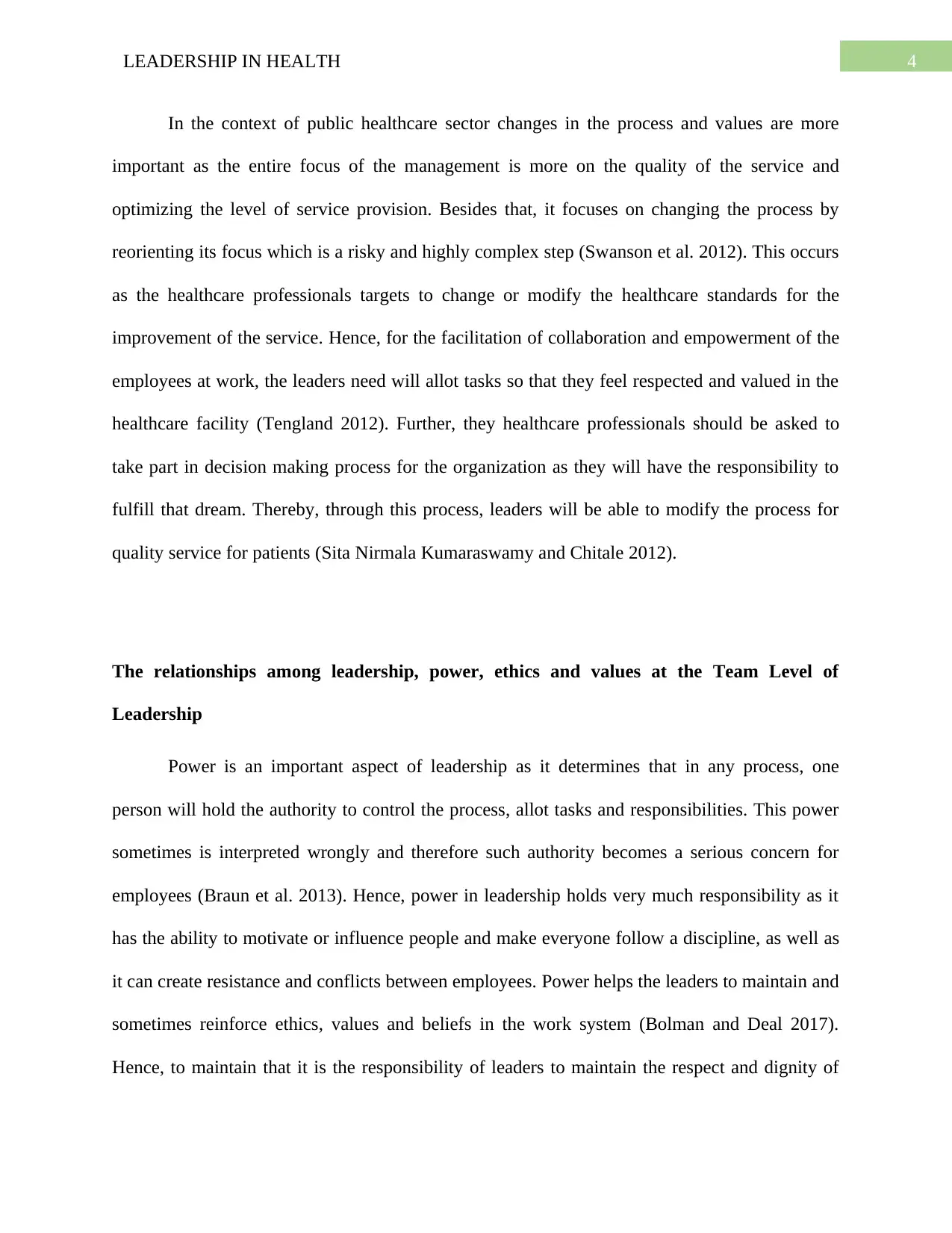
4LEADERSHIP IN HEALTH
In the context of public healthcare sector changes in the process and values are more
important as the entire focus of the management is more on the quality of the service and
optimizing the level of service provision. Besides that, it focuses on changing the process by
reorienting its focus which is a risky and highly complex step (Swanson et al. 2012). This occurs
as the healthcare professionals targets to change or modify the healthcare standards for the
improvement of the service. Hence, for the facilitation of collaboration and empowerment of the
employees at work, the leaders need will allot tasks so that they feel respected and valued in the
healthcare facility (Tengland 2012). Further, they healthcare professionals should be asked to
take part in decision making process for the organization as they will have the responsibility to
fulfill that dream. Thereby, through this process, leaders will be able to modify the process for
quality service for patients (Sita Nirmala Kumaraswamy and Chitale 2012).
The relationships among leadership, power, ethics and values at the Team Level of
Leadership
Power is an important aspect of leadership as it determines that in any process, one
person will hold the authority to control the process, allot tasks and responsibilities. This power
sometimes is interpreted wrongly and therefore such authority becomes a serious concern for
employees (Braun et al. 2013). Hence, power in leadership holds very much responsibility as it
has the ability to motivate or influence people and make everyone follow a discipline, as well as
it can create resistance and conflicts between employees. Power helps the leaders to maintain and
sometimes reinforce ethics, values and beliefs in the work system (Bolman and Deal 2017).
Hence, to maintain that it is the responsibility of leaders to maintain the respect and dignity of
In the context of public healthcare sector changes in the process and values are more
important as the entire focus of the management is more on the quality of the service and
optimizing the level of service provision. Besides that, it focuses on changing the process by
reorienting its focus which is a risky and highly complex step (Swanson et al. 2012). This occurs
as the healthcare professionals targets to change or modify the healthcare standards for the
improvement of the service. Hence, for the facilitation of collaboration and empowerment of the
employees at work, the leaders need will allot tasks so that they feel respected and valued in the
healthcare facility (Tengland 2012). Further, they healthcare professionals should be asked to
take part in decision making process for the organization as they will have the responsibility to
fulfill that dream. Thereby, through this process, leaders will be able to modify the process for
quality service for patients (Sita Nirmala Kumaraswamy and Chitale 2012).
The relationships among leadership, power, ethics and values at the Team Level of
Leadership
Power is an important aspect of leadership as it determines that in any process, one
person will hold the authority to control the process, allot tasks and responsibilities. This power
sometimes is interpreted wrongly and therefore such authority becomes a serious concern for
employees (Braun et al. 2013). Hence, power in leadership holds very much responsibility as it
has the ability to motivate or influence people and make everyone follow a discipline, as well as
it can create resistance and conflicts between employees. Power helps the leaders to maintain and
sometimes reinforce ethics, values and beliefs in the work system (Bolman and Deal 2017).
Hence, to maintain that it is the responsibility of leaders to maintain the respect and dignity of
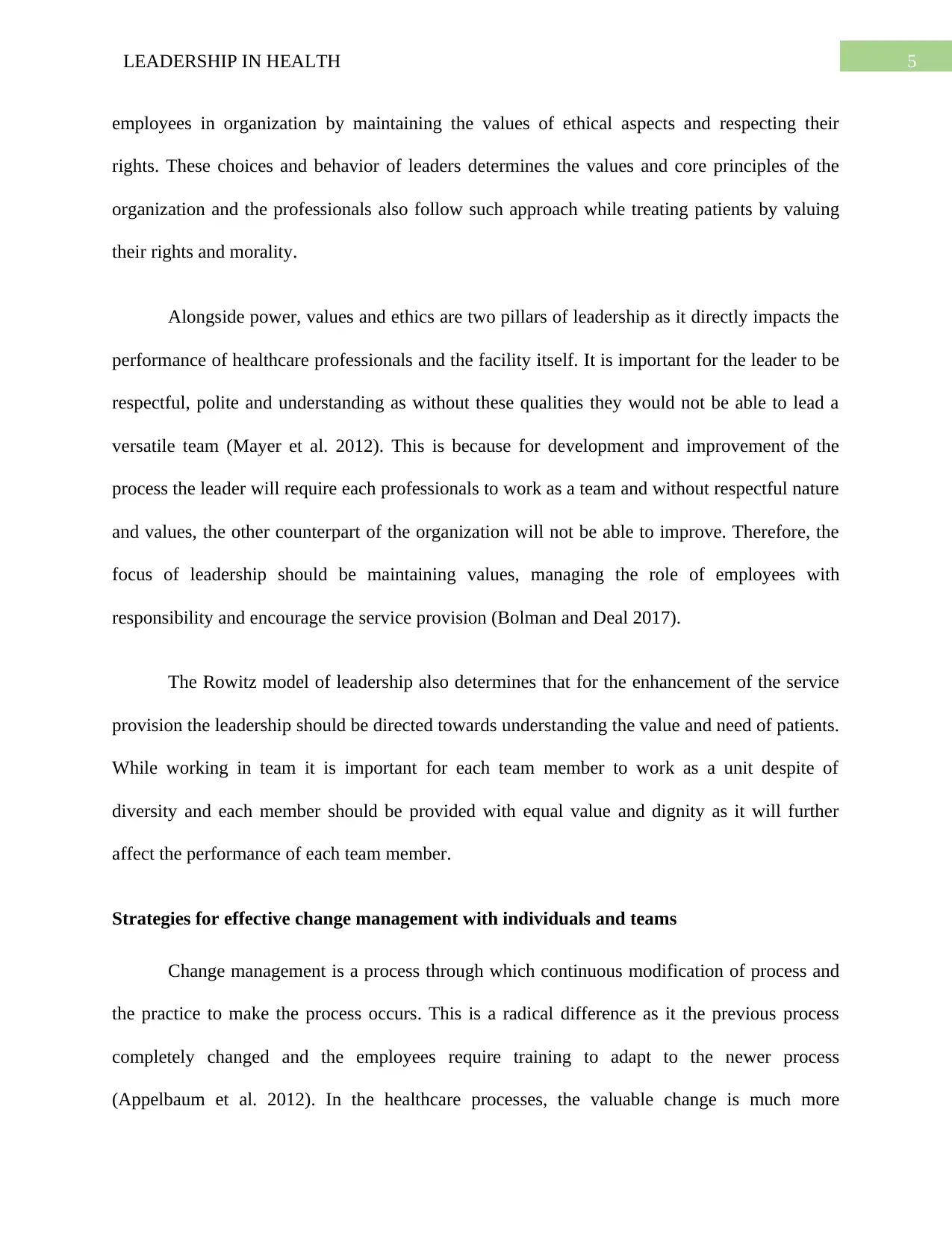
5LEADERSHIP IN HEALTH
employees in organization by maintaining the values of ethical aspects and respecting their
rights. These choices and behavior of leaders determines the values and core principles of the
organization and the professionals also follow such approach while treating patients by valuing
their rights and morality.
Alongside power, values and ethics are two pillars of leadership as it directly impacts the
performance of healthcare professionals and the facility itself. It is important for the leader to be
respectful, polite and understanding as without these qualities they would not be able to lead a
versatile team (Mayer et al. 2012). This is because for development and improvement of the
process the leader will require each professionals to work as a team and without respectful nature
and values, the other counterpart of the organization will not be able to improve. Therefore, the
focus of leadership should be maintaining values, managing the role of employees with
responsibility and encourage the service provision (Bolman and Deal 2017).
The Rowitz model of leadership also determines that for the enhancement of the service
provision the leadership should be directed towards understanding the value and need of patients.
While working in team it is important for each team member to work as a unit despite of
diversity and each member should be provided with equal value and dignity as it will further
affect the performance of each team member.
Strategies for effective change management with individuals and teams
Change management is a process through which continuous modification of process and
the practice to make the process occurs. This is a radical difference as it the previous process
completely changed and the employees require training to adapt to the newer process
(Appelbaum et al. 2012). In the healthcare processes, the valuable change is much more
employees in organization by maintaining the values of ethical aspects and respecting their
rights. These choices and behavior of leaders determines the values and core principles of the
organization and the professionals also follow such approach while treating patients by valuing
their rights and morality.
Alongside power, values and ethics are two pillars of leadership as it directly impacts the
performance of healthcare professionals and the facility itself. It is important for the leader to be
respectful, polite and understanding as without these qualities they would not be able to lead a
versatile team (Mayer et al. 2012). This is because for development and improvement of the
process the leader will require each professionals to work as a team and without respectful nature
and values, the other counterpart of the organization will not be able to improve. Therefore, the
focus of leadership should be maintaining values, managing the role of employees with
responsibility and encourage the service provision (Bolman and Deal 2017).
The Rowitz model of leadership also determines that for the enhancement of the service
provision the leadership should be directed towards understanding the value and need of patients.
While working in team it is important for each team member to work as a unit despite of
diversity and each member should be provided with equal value and dignity as it will further
affect the performance of each team member.
Strategies for effective change management with individuals and teams
Change management is a process through which continuous modification of process and
the practice to make the process occurs. This is a radical difference as it the previous process
completely changed and the employees require training to adapt to the newer process
(Appelbaum et al. 2012). In the healthcare processes, the valuable change is much more
You're viewing a preview
Unlock full access by subscribing today!
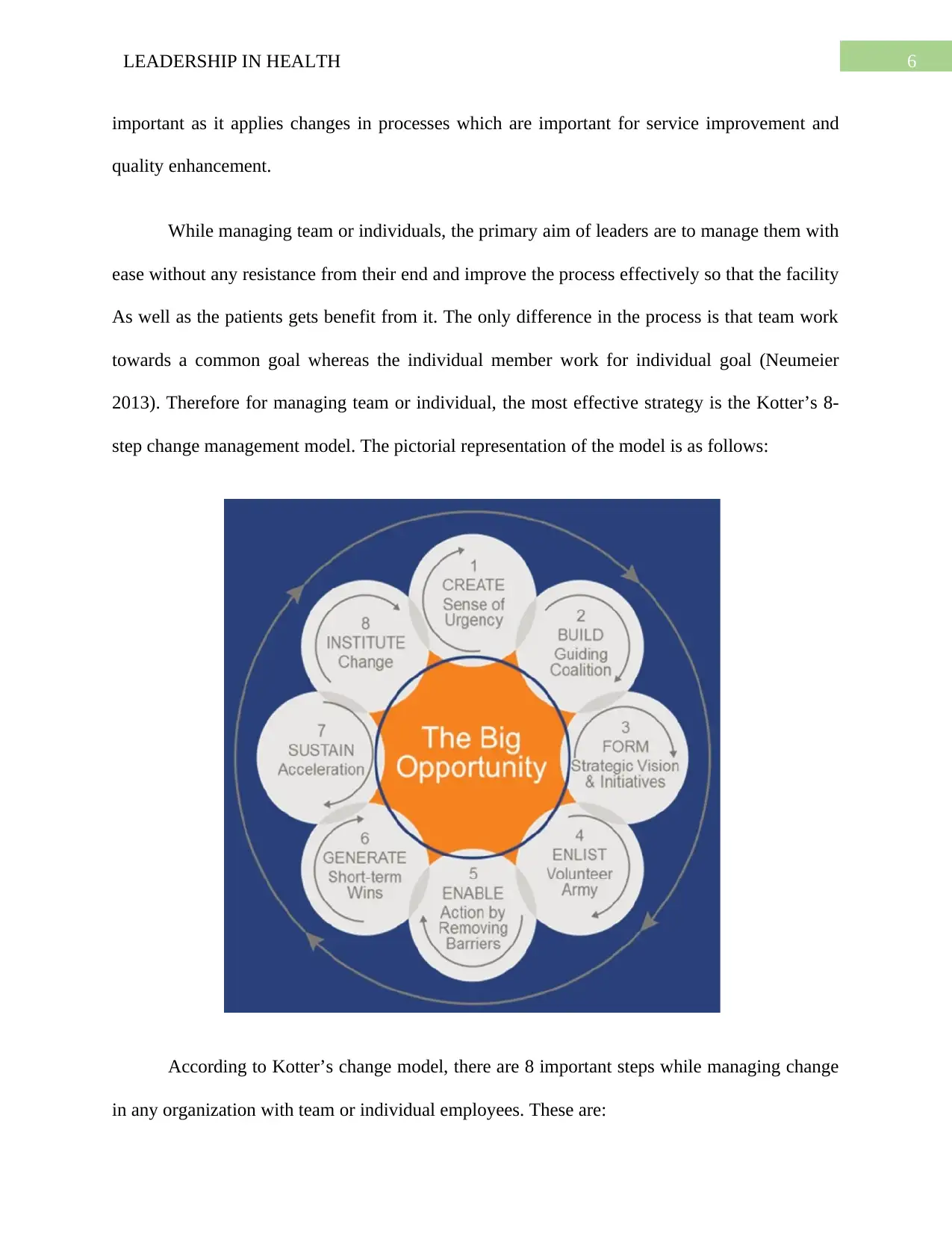
6LEADERSHIP IN HEALTH
important as it applies changes in processes which are important for service improvement and
quality enhancement.
While managing team or individuals, the primary aim of leaders are to manage them with
ease without any resistance from their end and improve the process effectively so that the facility
As well as the patients gets benefit from it. The only difference in the process is that team work
towards a common goal whereas the individual member work for individual goal (Neumeier
2013). Therefore for managing team or individual, the most effective strategy is the Kotter’s 8-
step change management model. The pictorial representation of the model is as follows:
According to Kotter’s change model, there are 8 important steps while managing change
in any organization with team or individual employees. These are:
important as it applies changes in processes which are important for service improvement and
quality enhancement.
While managing team or individuals, the primary aim of leaders are to manage them with
ease without any resistance from their end and improve the process effectively so that the facility
As well as the patients gets benefit from it. The only difference in the process is that team work
towards a common goal whereas the individual member work for individual goal (Neumeier
2013). Therefore for managing team or individual, the most effective strategy is the Kotter’s 8-
step change management model. The pictorial representation of the model is as follows:
According to Kotter’s change model, there are 8 important steps while managing change
in any organization with team or individual employees. These are:
Paraphrase This Document
Need a fresh take? Get an instant paraphrase of this document with our AI Paraphraser
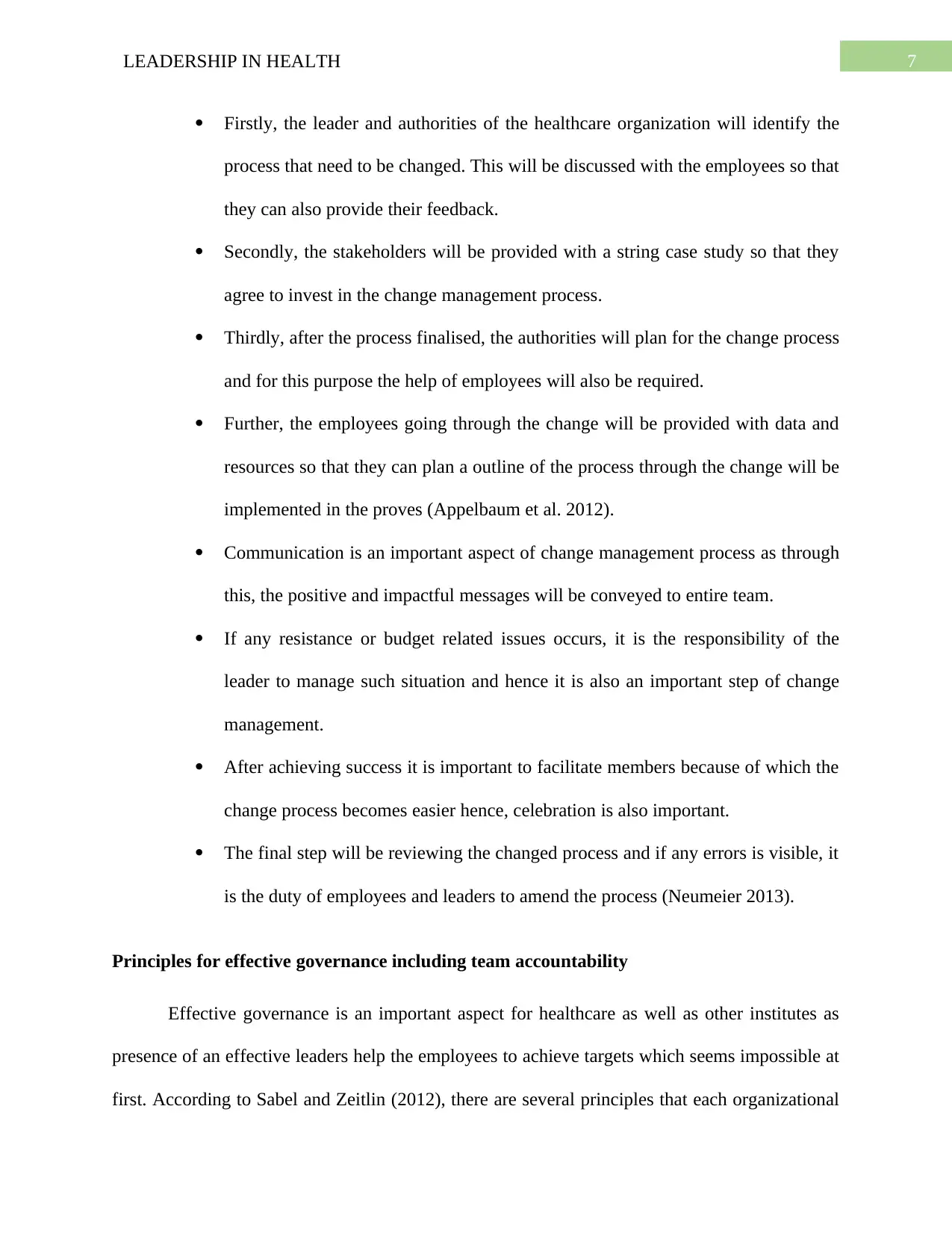
7LEADERSHIP IN HEALTH
Firstly, the leader and authorities of the healthcare organization will identify the
process that need to be changed. This will be discussed with the employees so that
they can also provide their feedback.
Secondly, the stakeholders will be provided with a string case study so that they
agree to invest in the change management process.
Thirdly, after the process finalised, the authorities will plan for the change process
and for this purpose the help of employees will also be required.
Further, the employees going through the change will be provided with data and
resources so that they can plan a outline of the process through the change will be
implemented in the proves (Appelbaum et al. 2012).
Communication is an important aspect of change management process as through
this, the positive and impactful messages will be conveyed to entire team.
If any resistance or budget related issues occurs, it is the responsibility of the
leader to manage such situation and hence it is also an important step of change
management.
After achieving success it is important to facilitate members because of which the
change process becomes easier hence, celebration is also important.
The final step will be reviewing the changed process and if any errors is visible, it
is the duty of employees and leaders to amend the process (Neumeier 2013).
Principles for effective governance including team accountability
Effective governance is an important aspect for healthcare as well as other institutes as
presence of an effective leaders help the employees to achieve targets which seems impossible at
first. According to Sabel and Zeitlin (2012), there are several principles that each organizational
Firstly, the leader and authorities of the healthcare organization will identify the
process that need to be changed. This will be discussed with the employees so that
they can also provide their feedback.
Secondly, the stakeholders will be provided with a string case study so that they
agree to invest in the change management process.
Thirdly, after the process finalised, the authorities will plan for the change process
and for this purpose the help of employees will also be required.
Further, the employees going through the change will be provided with data and
resources so that they can plan a outline of the process through the change will be
implemented in the proves (Appelbaum et al. 2012).
Communication is an important aspect of change management process as through
this, the positive and impactful messages will be conveyed to entire team.
If any resistance or budget related issues occurs, it is the responsibility of the
leader to manage such situation and hence it is also an important step of change
management.
After achieving success it is important to facilitate members because of which the
change process becomes easier hence, celebration is also important.
The final step will be reviewing the changed process and if any errors is visible, it
is the duty of employees and leaders to amend the process (Neumeier 2013).
Principles for effective governance including team accountability
Effective governance is an important aspect for healthcare as well as other institutes as
presence of an effective leaders help the employees to achieve targets which seems impossible at
first. According to Sabel and Zeitlin (2012), there are several principles that each organizational
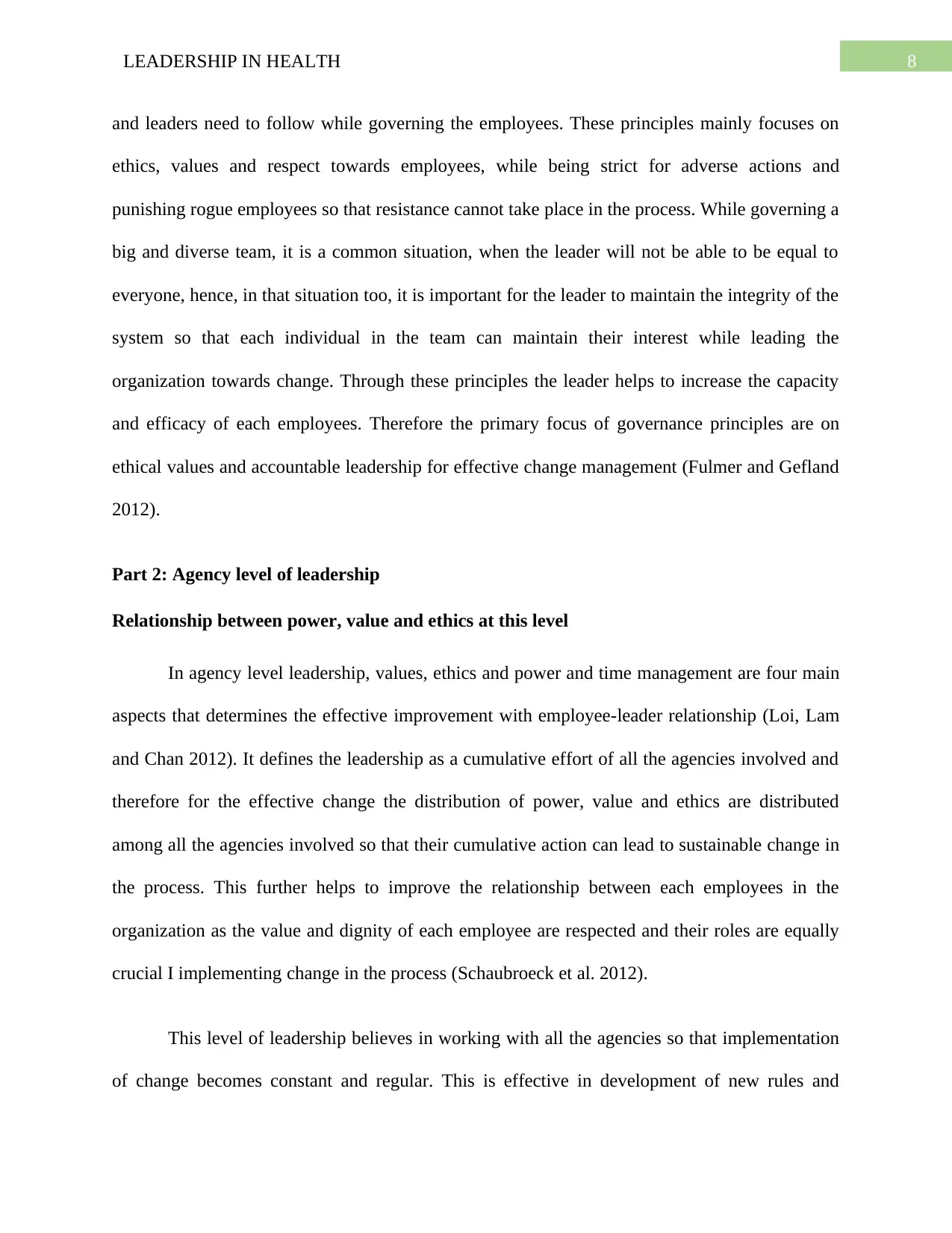
8LEADERSHIP IN HEALTH
and leaders need to follow while governing the employees. These principles mainly focuses on
ethics, values and respect towards employees, while being strict for adverse actions and
punishing rogue employees so that resistance cannot take place in the process. While governing a
big and diverse team, it is a common situation, when the leader will not be able to be equal to
everyone, hence, in that situation too, it is important for the leader to maintain the integrity of the
system so that each individual in the team can maintain their interest while leading the
organization towards change. Through these principles the leader helps to increase the capacity
and efficacy of each employees. Therefore the primary focus of governance principles are on
ethical values and accountable leadership for effective change management (Fulmer and Gefland
2012).
Part 2: Agency level of leadership
Relationship between power, value and ethics at this level
In agency level leadership, values, ethics and power and time management are four main
aspects that determines the effective improvement with employee-leader relationship (Loi, Lam
and Chan 2012). It defines the leadership as a cumulative effort of all the agencies involved and
therefore for the effective change the distribution of power, value and ethics are distributed
among all the agencies involved so that their cumulative action can lead to sustainable change in
the process. This further helps to improve the relationship between each employees in the
organization as the value and dignity of each employee are respected and their roles are equally
crucial I implementing change in the process (Schaubroeck et al. 2012).
This level of leadership believes in working with all the agencies so that implementation
of change becomes constant and regular. This is effective in development of new rules and
and leaders need to follow while governing the employees. These principles mainly focuses on
ethics, values and respect towards employees, while being strict for adverse actions and
punishing rogue employees so that resistance cannot take place in the process. While governing a
big and diverse team, it is a common situation, when the leader will not be able to be equal to
everyone, hence, in that situation too, it is important for the leader to maintain the integrity of the
system so that each individual in the team can maintain their interest while leading the
organization towards change. Through these principles the leader helps to increase the capacity
and efficacy of each employees. Therefore the primary focus of governance principles are on
ethical values and accountable leadership for effective change management (Fulmer and Gefland
2012).
Part 2: Agency level of leadership
Relationship between power, value and ethics at this level
In agency level leadership, values, ethics and power and time management are four main
aspects that determines the effective improvement with employee-leader relationship (Loi, Lam
and Chan 2012). It defines the leadership as a cumulative effort of all the agencies involved and
therefore for the effective change the distribution of power, value and ethics are distributed
among all the agencies involved so that their cumulative action can lead to sustainable change in
the process. This further helps to improve the relationship between each employees in the
organization as the value and dignity of each employee are respected and their roles are equally
crucial I implementing change in the process (Schaubroeck et al. 2012).
This level of leadership believes in working with all the agencies so that implementation
of change becomes constant and regular. This is effective in development of new rules and
You're viewing a preview
Unlock full access by subscribing today!
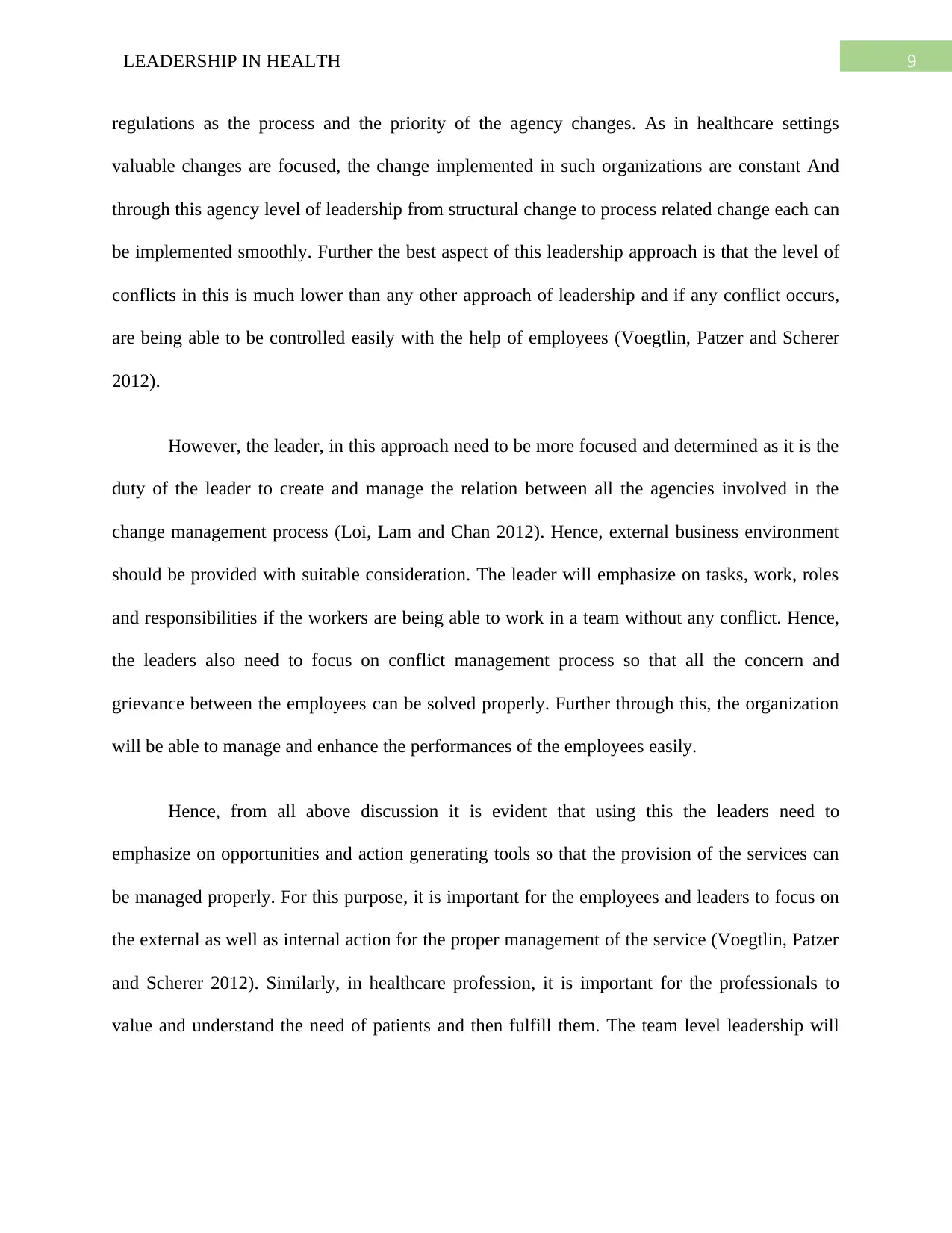
9LEADERSHIP IN HEALTH
regulations as the process and the priority of the agency changes. As in healthcare settings
valuable changes are focused, the change implemented in such organizations are constant And
through this agency level of leadership from structural change to process related change each can
be implemented smoothly. Further the best aspect of this leadership approach is that the level of
conflicts in this is much lower than any other approach of leadership and if any conflict occurs,
are being able to be controlled easily with the help of employees (Voegtlin, Patzer and Scherer
2012).
However, the leader, in this approach need to be more focused and determined as it is the
duty of the leader to create and manage the relation between all the agencies involved in the
change management process (Loi, Lam and Chan 2012). Hence, external business environment
should be provided with suitable consideration. The leader will emphasize on tasks, work, roles
and responsibilities if the workers are being able to work in a team without any conflict. Hence,
the leaders also need to focus on conflict management process so that all the concern and
grievance between the employees can be solved properly. Further through this, the organization
will be able to manage and enhance the performances of the employees easily.
Hence, from all above discussion it is evident that using this the leaders need to
emphasize on opportunities and action generating tools so that the provision of the services can
be managed properly. For this purpose, it is important for the employees and leaders to focus on
the external as well as internal action for the proper management of the service (Voegtlin, Patzer
and Scherer 2012). Similarly, in healthcare profession, it is important for the professionals to
value and understand the need of patients and then fulfill them. The team level leadership will
regulations as the process and the priority of the agency changes. As in healthcare settings
valuable changes are focused, the change implemented in such organizations are constant And
through this agency level of leadership from structural change to process related change each can
be implemented smoothly. Further the best aspect of this leadership approach is that the level of
conflicts in this is much lower than any other approach of leadership and if any conflict occurs,
are being able to be controlled easily with the help of employees (Voegtlin, Patzer and Scherer
2012).
However, the leader, in this approach need to be more focused and determined as it is the
duty of the leader to create and manage the relation between all the agencies involved in the
change management process (Loi, Lam and Chan 2012). Hence, external business environment
should be provided with suitable consideration. The leader will emphasize on tasks, work, roles
and responsibilities if the workers are being able to work in a team without any conflict. Hence,
the leaders also need to focus on conflict management process so that all the concern and
grievance between the employees can be solved properly. Further through this, the organization
will be able to manage and enhance the performances of the employees easily.
Hence, from all above discussion it is evident that using this the leaders need to
emphasize on opportunities and action generating tools so that the provision of the services can
be managed properly. For this purpose, it is important for the employees and leaders to focus on
the external as well as internal action for the proper management of the service (Voegtlin, Patzer
and Scherer 2012). Similarly, in healthcare profession, it is important for the professionals to
value and understand the need of patients and then fulfill them. The team level leadership will
Paraphrase This Document
Need a fresh take? Get an instant paraphrase of this document with our AI Paraphraser
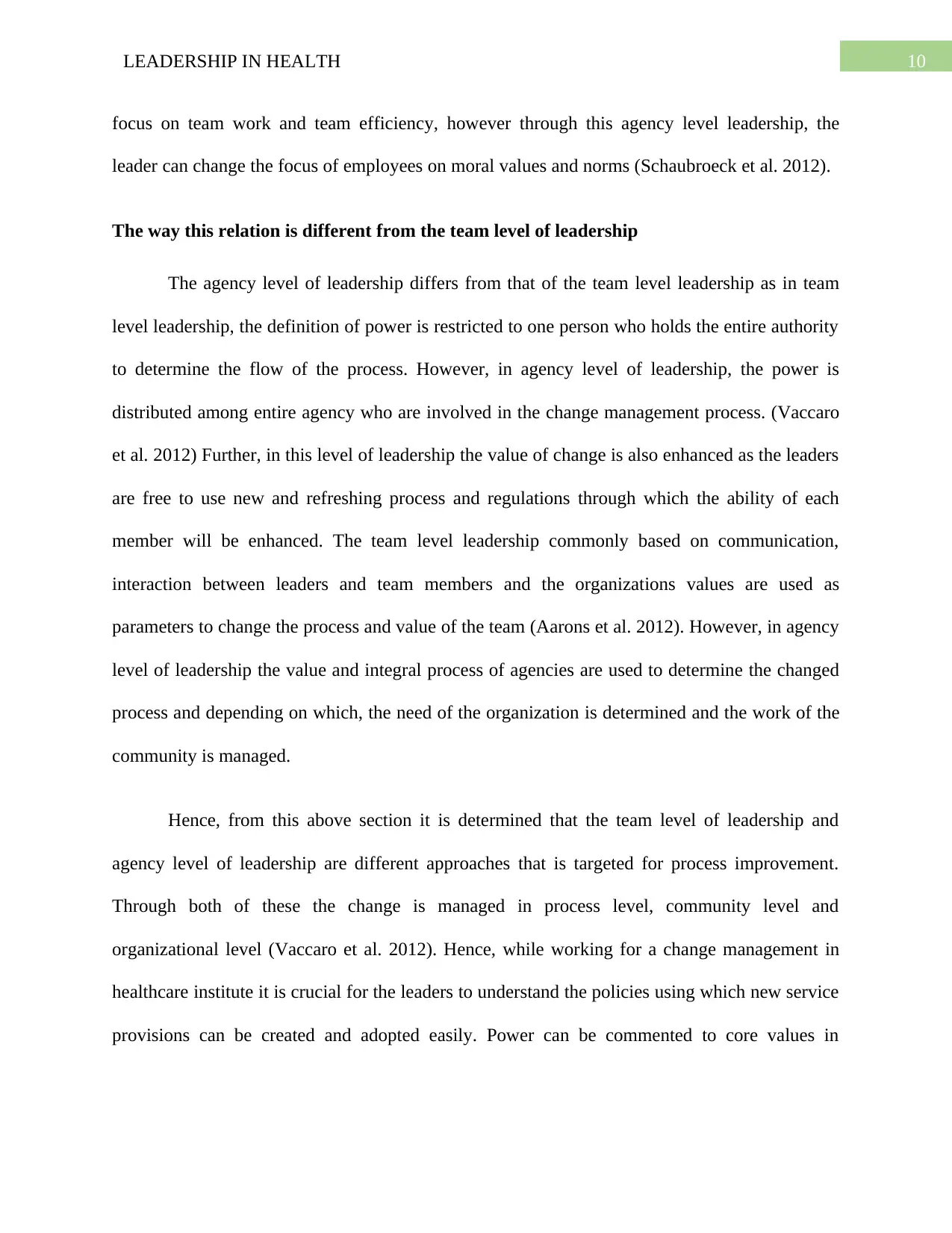
10LEADERSHIP IN HEALTH
focus on team work and team efficiency, however through this agency level leadership, the
leader can change the focus of employees on moral values and norms (Schaubroeck et al. 2012).
The way this relation is different from the team level of leadership
The agency level of leadership differs from that of the team level leadership as in team
level leadership, the definition of power is restricted to one person who holds the entire authority
to determine the flow of the process. However, in agency level of leadership, the power is
distributed among entire agency who are involved in the change management process. (Vaccaro
et al. 2012) Further, in this level of leadership the value of change is also enhanced as the leaders
are free to use new and refreshing process and regulations through which the ability of each
member will be enhanced. The team level leadership commonly based on communication,
interaction between leaders and team members and the organizations values are used as
parameters to change the process and value of the team (Aarons et al. 2012). However, in agency
level of leadership the value and integral process of agencies are used to determine the changed
process and depending on which, the need of the organization is determined and the work of the
community is managed.
Hence, from this above section it is determined that the team level of leadership and
agency level of leadership are different approaches that is targeted for process improvement.
Through both of these the change is managed in process level, community level and
organizational level (Vaccaro et al. 2012). Hence, while working for a change management in
healthcare institute it is crucial for the leaders to understand the policies using which new service
provisions can be created and adopted easily. Power can be commented to core values in
focus on team work and team efficiency, however through this agency level leadership, the
leader can change the focus of employees on moral values and norms (Schaubroeck et al. 2012).
The way this relation is different from the team level of leadership
The agency level of leadership differs from that of the team level leadership as in team
level leadership, the definition of power is restricted to one person who holds the entire authority
to determine the flow of the process. However, in agency level of leadership, the power is
distributed among entire agency who are involved in the change management process. (Vaccaro
et al. 2012) Further, in this level of leadership the value of change is also enhanced as the leaders
are free to use new and refreshing process and regulations through which the ability of each
member will be enhanced. The team level leadership commonly based on communication,
interaction between leaders and team members and the organizations values are used as
parameters to change the process and value of the team (Aarons et al. 2012). However, in agency
level of leadership the value and integral process of agencies are used to determine the changed
process and depending on which, the need of the organization is determined and the work of the
community is managed.
Hence, from this above section it is determined that the team level of leadership and
agency level of leadership are different approaches that is targeted for process improvement.
Through both of these the change is managed in process level, community level and
organizational level (Vaccaro et al. 2012). Hence, while working for a change management in
healthcare institute it is crucial for the leaders to understand the policies using which new service
provisions can be created and adopted easily. Power can be commented to core values in
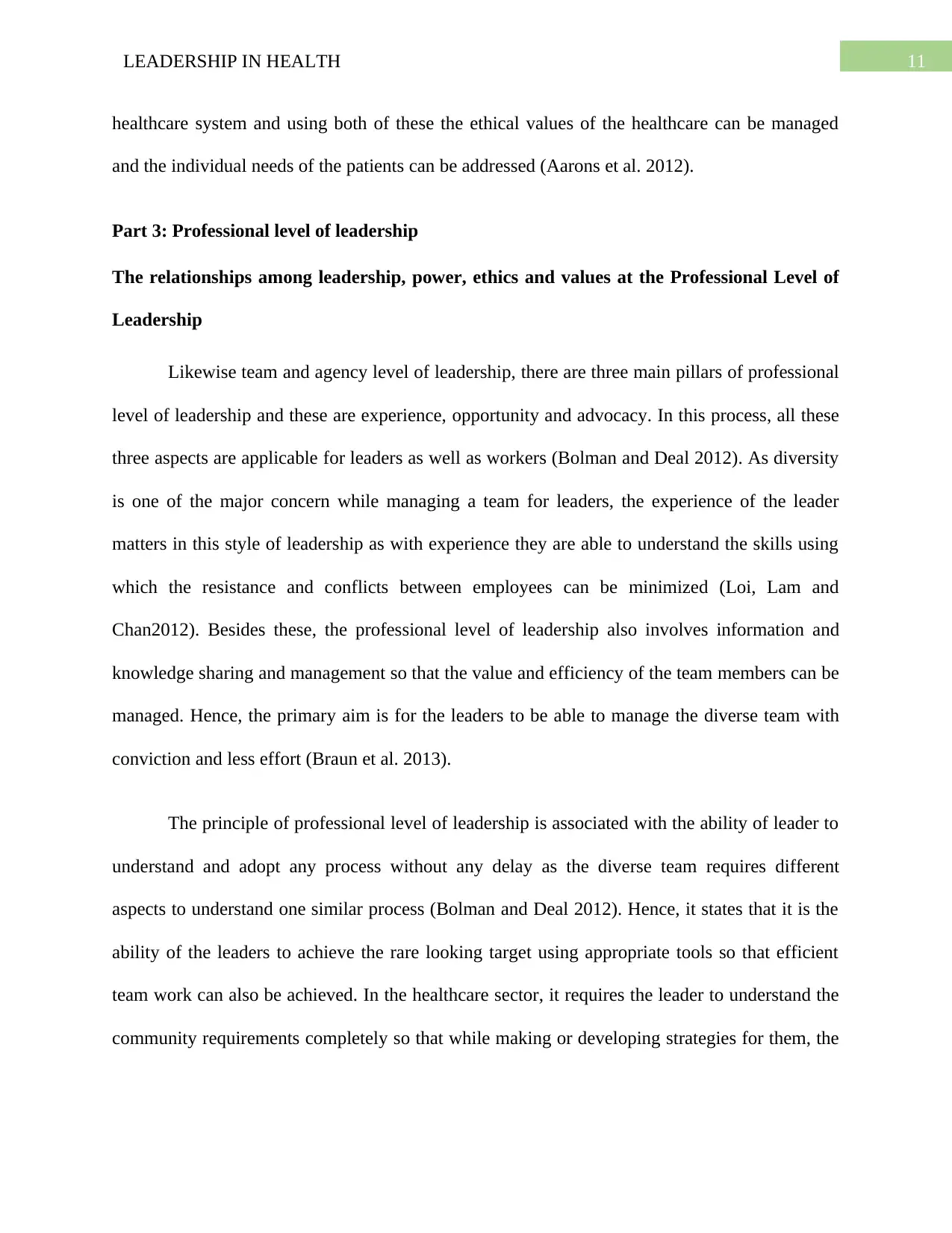
11LEADERSHIP IN HEALTH
healthcare system and using both of these the ethical values of the healthcare can be managed
and the individual needs of the patients can be addressed (Aarons et al. 2012).
Part 3: Professional level of leadership
The relationships among leadership, power, ethics and values at the Professional Level of
Leadership
Likewise team and agency level of leadership, there are three main pillars of professional
level of leadership and these are experience, opportunity and advocacy. In this process, all these
three aspects are applicable for leaders as well as workers (Bolman and Deal 2012). As diversity
is one of the major concern while managing a team for leaders, the experience of the leader
matters in this style of leadership as with experience they are able to understand the skills using
which the resistance and conflicts between employees can be minimized (Loi, Lam and
Chan2012). Besides these, the professional level of leadership also involves information and
knowledge sharing and management so that the value and efficiency of the team members can be
managed. Hence, the primary aim is for the leaders to be able to manage the diverse team with
conviction and less effort (Braun et al. 2013).
The principle of professional level of leadership is associated with the ability of leader to
understand and adopt any process without any delay as the diverse team requires different
aspects to understand one similar process (Bolman and Deal 2012). Hence, it states that it is the
ability of the leaders to achieve the rare looking target using appropriate tools so that efficient
team work can also be achieved. In the healthcare sector, it requires the leader to understand the
community requirements completely so that while making or developing strategies for them, the
healthcare system and using both of these the ethical values of the healthcare can be managed
and the individual needs of the patients can be addressed (Aarons et al. 2012).
Part 3: Professional level of leadership
The relationships among leadership, power, ethics and values at the Professional Level of
Leadership
Likewise team and agency level of leadership, there are three main pillars of professional
level of leadership and these are experience, opportunity and advocacy. In this process, all these
three aspects are applicable for leaders as well as workers (Bolman and Deal 2012). As diversity
is one of the major concern while managing a team for leaders, the experience of the leader
matters in this style of leadership as with experience they are able to understand the skills using
which the resistance and conflicts between employees can be minimized (Loi, Lam and
Chan2012). Besides these, the professional level of leadership also involves information and
knowledge sharing and management so that the value and efficiency of the team members can be
managed. Hence, the primary aim is for the leaders to be able to manage the diverse team with
conviction and less effort (Braun et al. 2013).
The principle of professional level of leadership is associated with the ability of leader to
understand and adopt any process without any delay as the diverse team requires different
aspects to understand one similar process (Bolman and Deal 2012). Hence, it states that it is the
ability of the leaders to achieve the rare looking target using appropriate tools so that efficient
team work can also be achieved. In the healthcare sector, it requires the leader to understand the
community requirements completely so that while making or developing strategies for them, the
You're viewing a preview
Unlock full access by subscribing today!
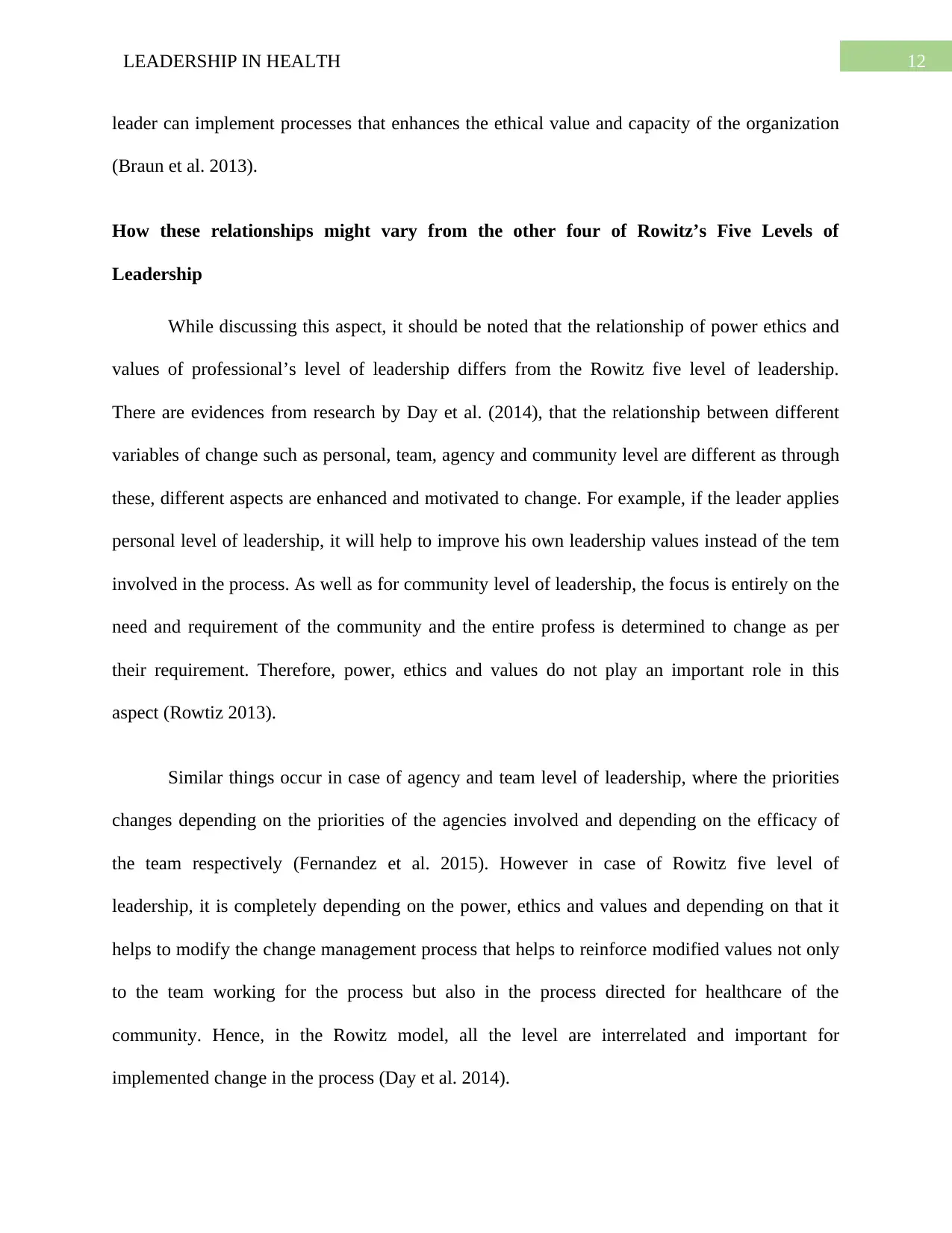
12LEADERSHIP IN HEALTH
leader can implement processes that enhances the ethical value and capacity of the organization
(Braun et al. 2013).
How these relationships might vary from the other four of Rowitz’s Five Levels of
Leadership
While discussing this aspect, it should be noted that the relationship of power ethics and
values of professional’s level of leadership differs from the Rowitz five level of leadership.
There are evidences from research by Day et al. (2014), that the relationship between different
variables of change such as personal, team, agency and community level are different as through
these, different aspects are enhanced and motivated to change. For example, if the leader applies
personal level of leadership, it will help to improve his own leadership values instead of the tem
involved in the process. As well as for community level of leadership, the focus is entirely on the
need and requirement of the community and the entire profess is determined to change as per
their requirement. Therefore, power, ethics and values do not play an important role in this
aspect (Rowtiz 2013).
Similar things occur in case of agency and team level of leadership, where the priorities
changes depending on the priorities of the agencies involved and depending on the efficacy of
the team respectively (Fernandez et al. 2015). However in case of Rowitz five level of
leadership, it is completely depending on the power, ethics and values and depending on that it
helps to modify the change management process that helps to reinforce modified values not only
to the team working for the process but also in the process directed for healthcare of the
community. Hence, in the Rowitz model, all the level are interrelated and important for
implemented change in the process (Day et al. 2014).
leader can implement processes that enhances the ethical value and capacity of the organization
(Braun et al. 2013).
How these relationships might vary from the other four of Rowitz’s Five Levels of
Leadership
While discussing this aspect, it should be noted that the relationship of power ethics and
values of professional’s level of leadership differs from the Rowitz five level of leadership.
There are evidences from research by Day et al. (2014), that the relationship between different
variables of change such as personal, team, agency and community level are different as through
these, different aspects are enhanced and motivated to change. For example, if the leader applies
personal level of leadership, it will help to improve his own leadership values instead of the tem
involved in the process. As well as for community level of leadership, the focus is entirely on the
need and requirement of the community and the entire profess is determined to change as per
their requirement. Therefore, power, ethics and values do not play an important role in this
aspect (Rowtiz 2013).
Similar things occur in case of agency and team level of leadership, where the priorities
changes depending on the priorities of the agencies involved and depending on the efficacy of
the team respectively (Fernandez et al. 2015). However in case of Rowitz five level of
leadership, it is completely depending on the power, ethics and values and depending on that it
helps to modify the change management process that helps to reinforce modified values not only
to the team working for the process but also in the process directed for healthcare of the
community. Hence, in the Rowitz model, all the level are interrelated and important for
implemented change in the process (Day et al. 2014).
Paraphrase This Document
Need a fresh take? Get an instant paraphrase of this document with our AI Paraphraser
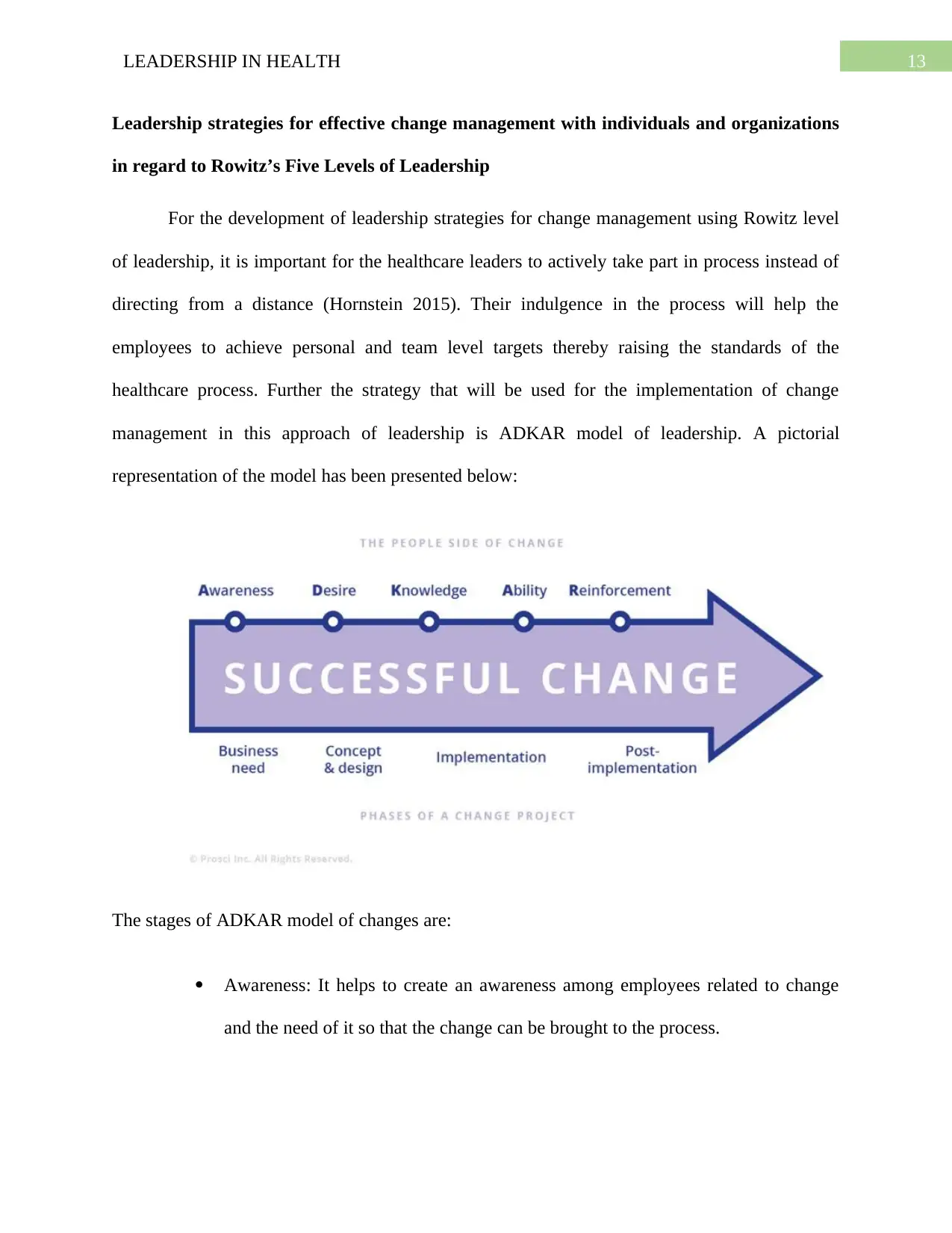
13LEADERSHIP IN HEALTH
Leadership strategies for effective change management with individuals and organizations
in regard to Rowitz’s Five Levels of Leadership
For the development of leadership strategies for change management using Rowitz level
of leadership, it is important for the healthcare leaders to actively take part in process instead of
directing from a distance (Hornstein 2015). Their indulgence in the process will help the
employees to achieve personal and team level targets thereby raising the standards of the
healthcare process. Further the strategy that will be used for the implementation of change
management in this approach of leadership is ADKAR model of leadership. A pictorial
representation of the model has been presented below:
The stages of ADKAR model of changes are:
Awareness: It helps to create an awareness among employees related to change
and the need of it so that the change can be brought to the process.
Leadership strategies for effective change management with individuals and organizations
in regard to Rowitz’s Five Levels of Leadership
For the development of leadership strategies for change management using Rowitz level
of leadership, it is important for the healthcare leaders to actively take part in process instead of
directing from a distance (Hornstein 2015). Their indulgence in the process will help the
employees to achieve personal and team level targets thereby raising the standards of the
healthcare process. Further the strategy that will be used for the implementation of change
management in this approach of leadership is ADKAR model of leadership. A pictorial
representation of the model has been presented below:
The stages of ADKAR model of changes are:
Awareness: It helps to create an awareness among employees related to change
and the need of it so that the change can be brought to the process.
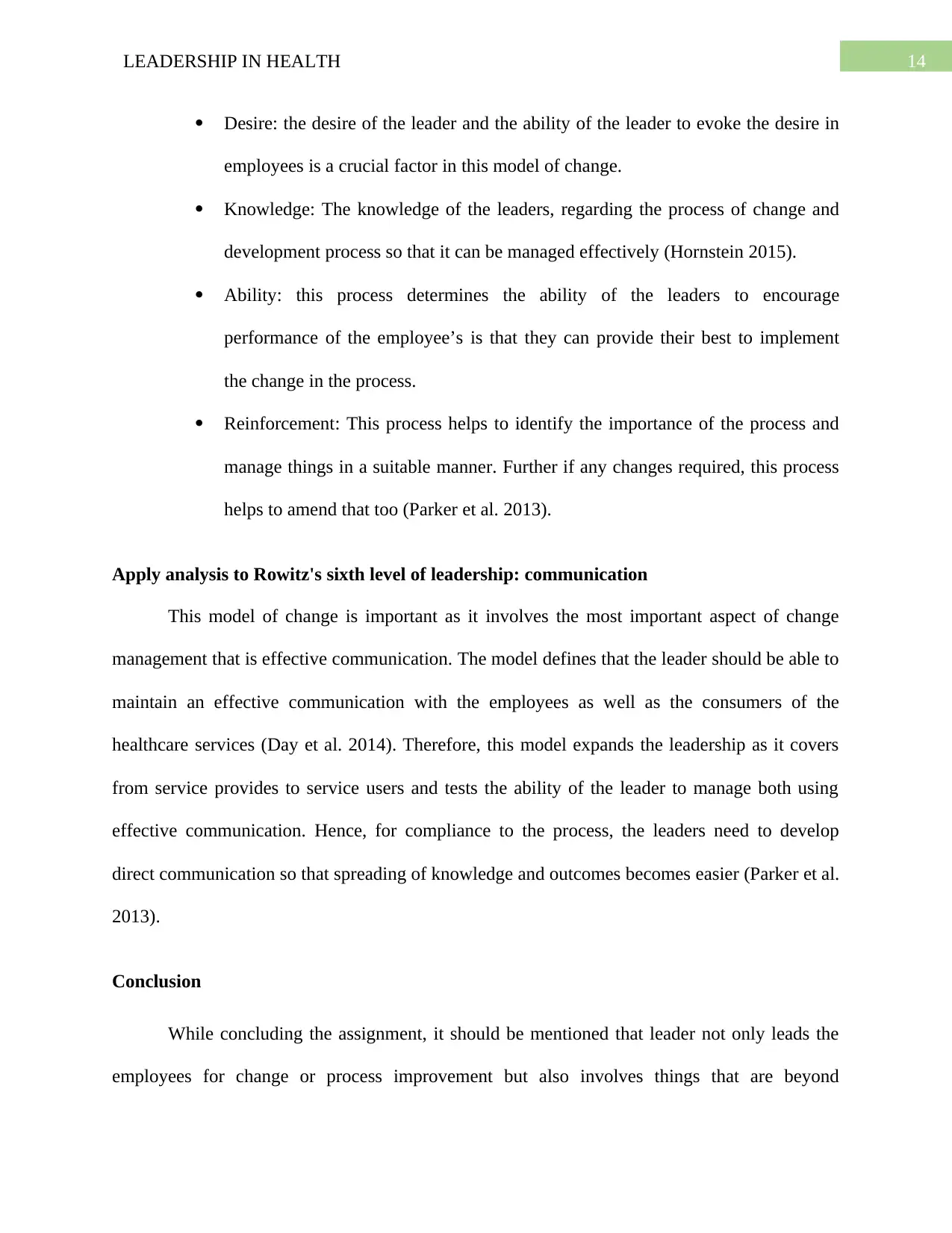
14LEADERSHIP IN HEALTH
Desire: the desire of the leader and the ability of the leader to evoke the desire in
employees is a crucial factor in this model of change.
Knowledge: The knowledge of the leaders, regarding the process of change and
development process so that it can be managed effectively (Hornstein 2015).
Ability: this process determines the ability of the leaders to encourage
performance of the employee’s is that they can provide their best to implement
the change in the process.
Reinforcement: This process helps to identify the importance of the process and
manage things in a suitable manner. Further if any changes required, this process
helps to amend that too (Parker et al. 2013).
Apply analysis to Rowitz's sixth level of leadership: communication
This model of change is important as it involves the most important aspect of change
management that is effective communication. The model defines that the leader should be able to
maintain an effective communication with the employees as well as the consumers of the
healthcare services (Day et al. 2014). Therefore, this model expands the leadership as it covers
from service provides to service users and tests the ability of the leader to manage both using
effective communication. Hence, for compliance to the process, the leaders need to develop
direct communication so that spreading of knowledge and outcomes becomes easier (Parker et al.
2013).
Conclusion
While concluding the assignment, it should be mentioned that leader not only leads the
employees for change or process improvement but also involves things that are beyond
Desire: the desire of the leader and the ability of the leader to evoke the desire in
employees is a crucial factor in this model of change.
Knowledge: The knowledge of the leaders, regarding the process of change and
development process so that it can be managed effectively (Hornstein 2015).
Ability: this process determines the ability of the leaders to encourage
performance of the employee’s is that they can provide their best to implement
the change in the process.
Reinforcement: This process helps to identify the importance of the process and
manage things in a suitable manner. Further if any changes required, this process
helps to amend that too (Parker et al. 2013).
Apply analysis to Rowitz's sixth level of leadership: communication
This model of change is important as it involves the most important aspect of change
management that is effective communication. The model defines that the leader should be able to
maintain an effective communication with the employees as well as the consumers of the
healthcare services (Day et al. 2014). Therefore, this model expands the leadership as it covers
from service provides to service users and tests the ability of the leader to manage both using
effective communication. Hence, for compliance to the process, the leaders need to develop
direct communication so that spreading of knowledge and outcomes becomes easier (Parker et al.
2013).
Conclusion
While concluding the assignment, it should be mentioned that leader not only leads the
employees for change or process improvement but also involves things that are beyond
You're viewing a preview
Unlock full access by subscribing today!
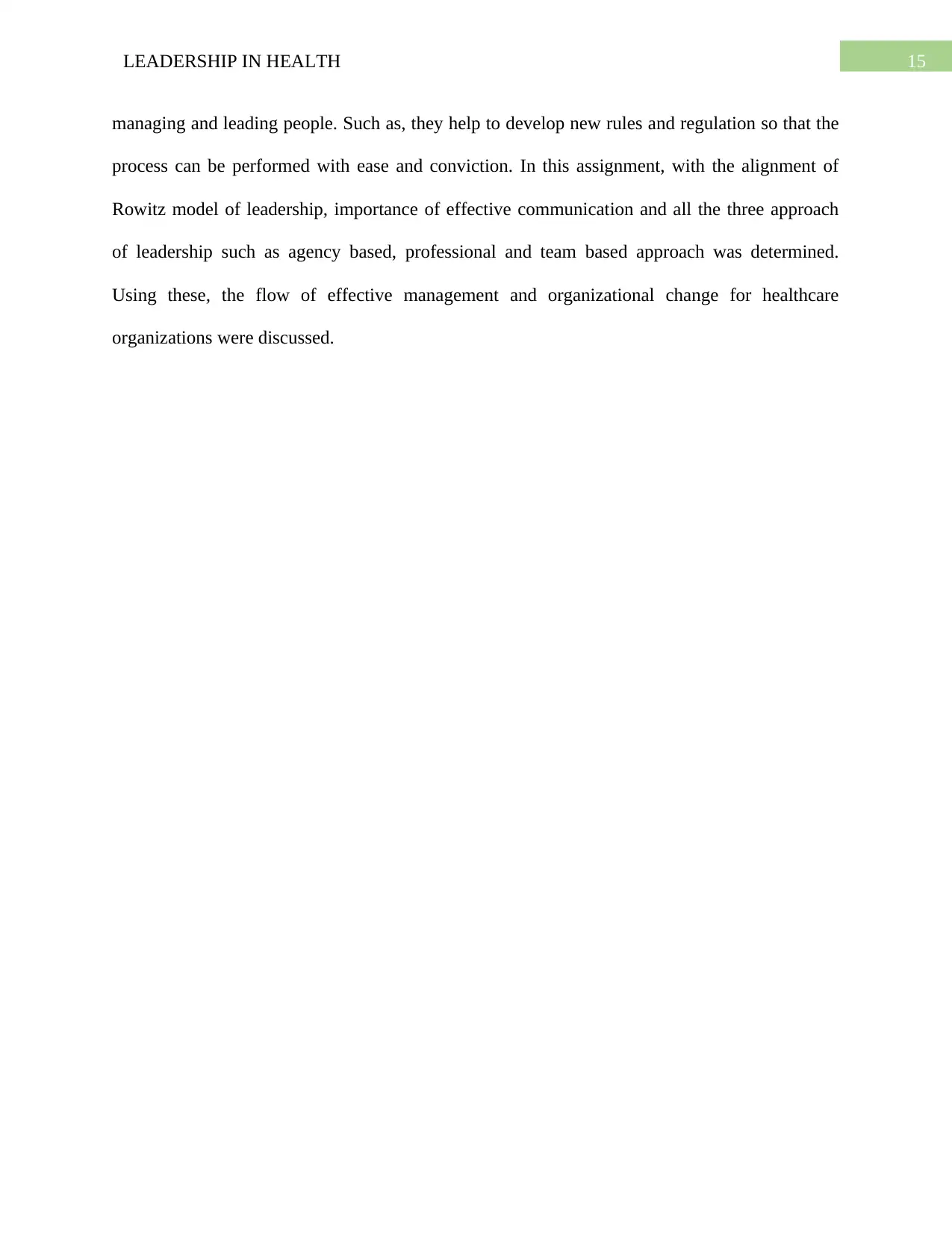
15LEADERSHIP IN HEALTH
managing and leading people. Such as, they help to develop new rules and regulation so that the
process can be performed with ease and conviction. In this assignment, with the alignment of
Rowitz model of leadership, importance of effective communication and all the three approach
of leadership such as agency based, professional and team based approach was determined.
Using these, the flow of effective management and organizational change for healthcare
organizations were discussed.
managing and leading people. Such as, they help to develop new rules and regulation so that the
process can be performed with ease and conviction. In this assignment, with the alignment of
Rowitz model of leadership, importance of effective communication and all the three approach
of leadership such as agency based, professional and team based approach was determined.
Using these, the flow of effective management and organizational change for healthcare
organizations were discussed.
Paraphrase This Document
Need a fresh take? Get an instant paraphrase of this document with our AI Paraphraser
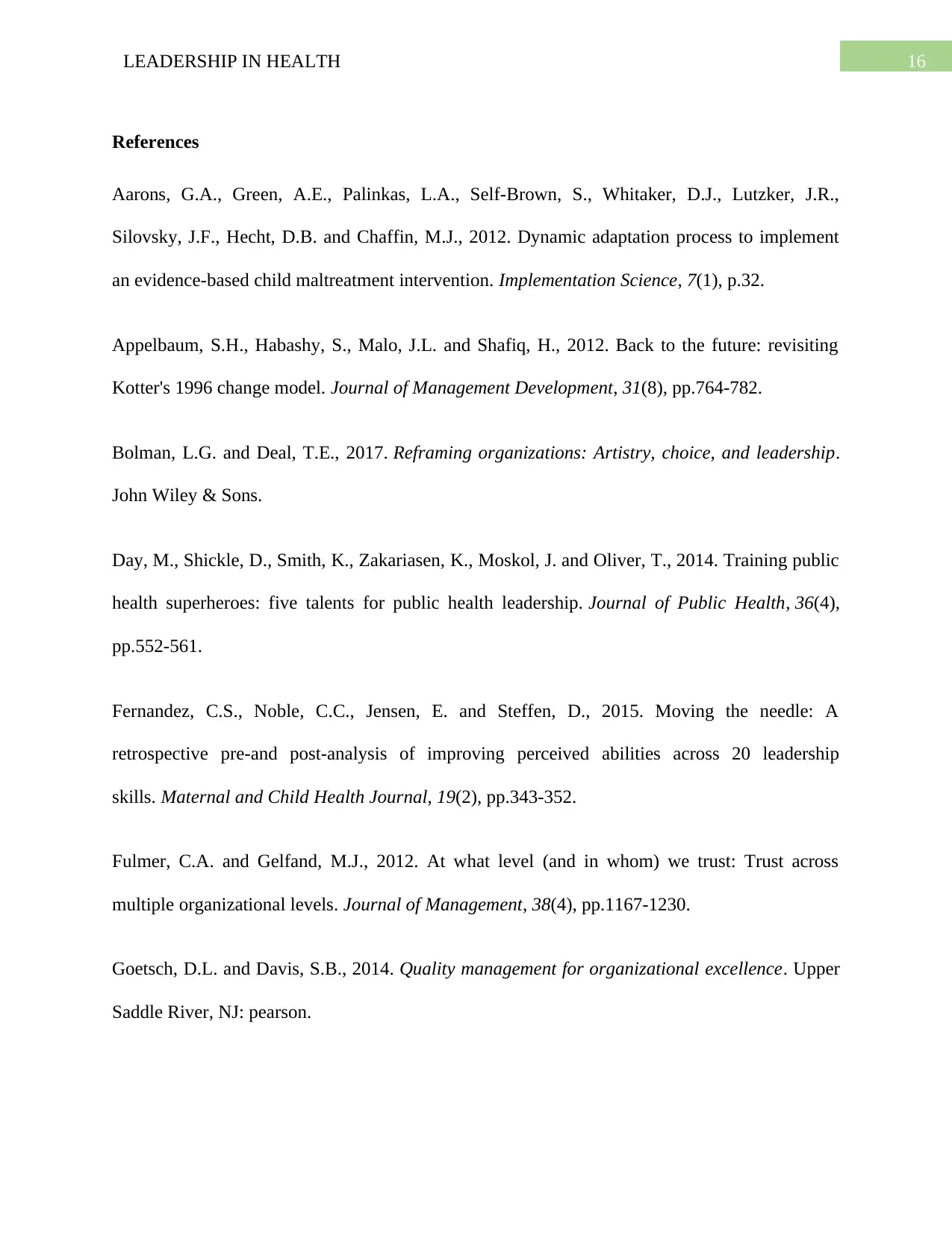
16LEADERSHIP IN HEALTH
References
Aarons, G.A., Green, A.E., Palinkas, L.A., Self-Brown, S., Whitaker, D.J., Lutzker, J.R.,
Silovsky, J.F., Hecht, D.B. and Chaffin, M.J., 2012. Dynamic adaptation process to implement
an evidence-based child maltreatment intervention. Implementation Science, 7(1), p.32.
Appelbaum, S.H., Habashy, S., Malo, J.L. and Shafiq, H., 2012. Back to the future: revisiting
Kotter's 1996 change model. Journal of Management Development, 31(8), pp.764-782.
Bolman, L.G. and Deal, T.E., 2017. Reframing organizations: Artistry, choice, and leadership.
John Wiley & Sons.
Day, M., Shickle, D., Smith, K., Zakariasen, K., Moskol, J. and Oliver, T., 2014. Training public
health superheroes: five talents for public health leadership. Journal of Public Health, 36(4),
pp.552-561.
Fernandez, C.S., Noble, C.C., Jensen, E. and Steffen, D., 2015. Moving the needle: A
retrospective pre-and post-analysis of improving perceived abilities across 20 leadership
skills. Maternal and Child Health Journal, 19(2), pp.343-352.
Fulmer, C.A. and Gelfand, M.J., 2012. At what level (and in whom) we trust: Trust across
multiple organizational levels. Journal of Management, 38(4), pp.1167-1230.
Goetsch, D.L. and Davis, S.B., 2014. Quality management for organizational excellence. Upper
Saddle River, NJ: pearson.
References
Aarons, G.A., Green, A.E., Palinkas, L.A., Self-Brown, S., Whitaker, D.J., Lutzker, J.R.,
Silovsky, J.F., Hecht, D.B. and Chaffin, M.J., 2012. Dynamic adaptation process to implement
an evidence-based child maltreatment intervention. Implementation Science, 7(1), p.32.
Appelbaum, S.H., Habashy, S., Malo, J.L. and Shafiq, H., 2012. Back to the future: revisiting
Kotter's 1996 change model. Journal of Management Development, 31(8), pp.764-782.
Bolman, L.G. and Deal, T.E., 2017. Reframing organizations: Artistry, choice, and leadership.
John Wiley & Sons.
Day, M., Shickle, D., Smith, K., Zakariasen, K., Moskol, J. and Oliver, T., 2014. Training public
health superheroes: five talents for public health leadership. Journal of Public Health, 36(4),
pp.552-561.
Fernandez, C.S., Noble, C.C., Jensen, E. and Steffen, D., 2015. Moving the needle: A
retrospective pre-and post-analysis of improving perceived abilities across 20 leadership
skills. Maternal and Child Health Journal, 19(2), pp.343-352.
Fulmer, C.A. and Gelfand, M.J., 2012. At what level (and in whom) we trust: Trust across
multiple organizational levels. Journal of Management, 38(4), pp.1167-1230.
Goetsch, D.L. and Davis, S.B., 2014. Quality management for organizational excellence. Upper
Saddle River, NJ: pearson.
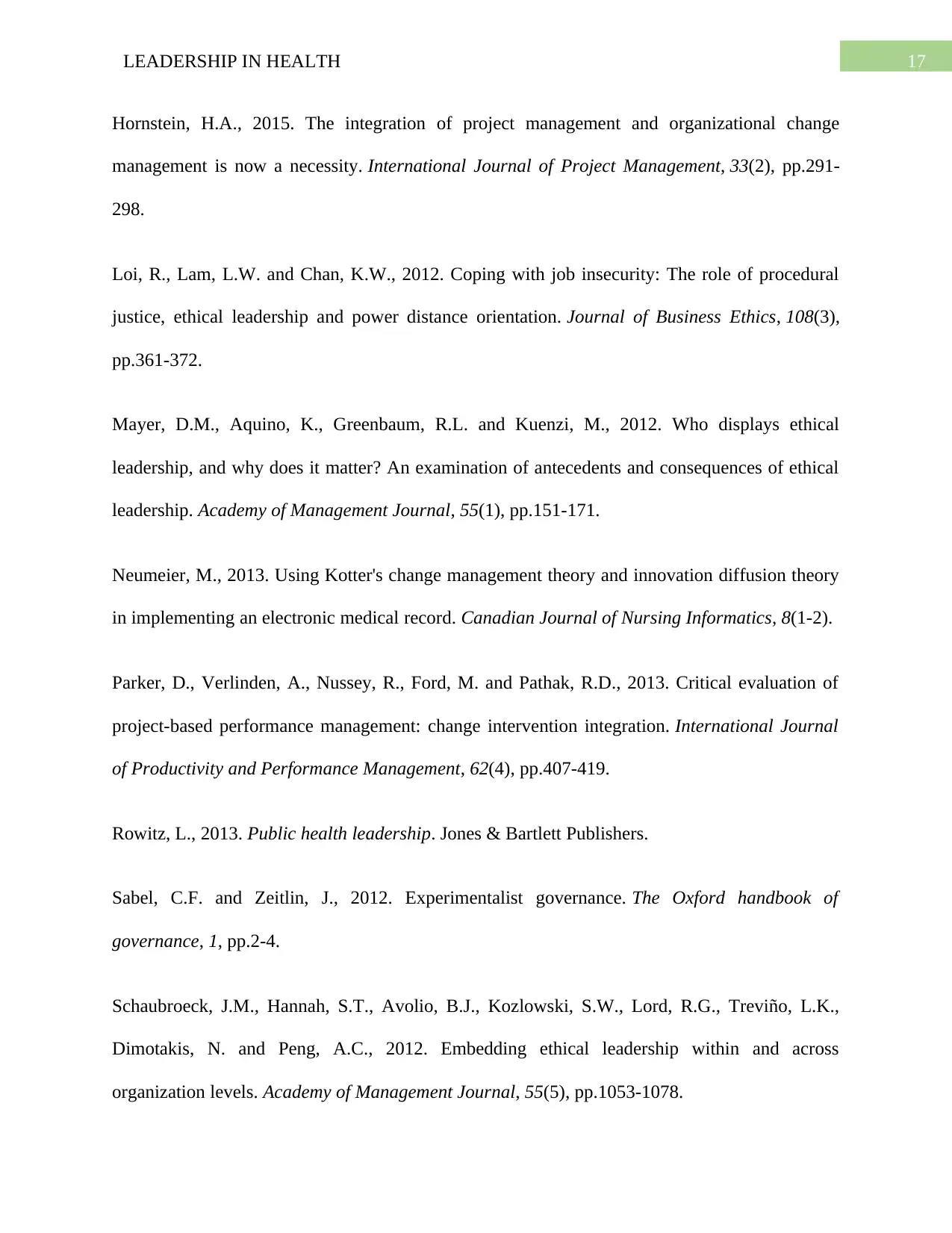
17LEADERSHIP IN HEALTH
Hornstein, H.A., 2015. The integration of project management and organizational change
management is now a necessity. International Journal of Project Management, 33(2), pp.291-
298.
Loi, R., Lam, L.W. and Chan, K.W., 2012. Coping with job insecurity: The role of procedural
justice, ethical leadership and power distance orientation. Journal of Business Ethics, 108(3),
pp.361-372.
Mayer, D.M., Aquino, K., Greenbaum, R.L. and Kuenzi, M., 2012. Who displays ethical
leadership, and why does it matter? An examination of antecedents and consequences of ethical
leadership. Academy of Management Journal, 55(1), pp.151-171.
Neumeier, M., 2013. Using Kotter's change management theory and innovation diffusion theory
in implementing an electronic medical record. Canadian Journal of Nursing Informatics, 8(1-2).
Parker, D., Verlinden, A., Nussey, R., Ford, M. and Pathak, R.D., 2013. Critical evaluation of
project-based performance management: change intervention integration. International Journal
of Productivity and Performance Management, 62(4), pp.407-419.
Rowitz, L., 2013. Public health leadership. Jones & Bartlett Publishers.
Sabel, C.F. and Zeitlin, J., 2012. Experimentalist governance. The Oxford handbook of
governance, 1, pp.2-4.
Schaubroeck, J.M., Hannah, S.T., Avolio, B.J., Kozlowski, S.W., Lord, R.G., Treviño, L.K.,
Dimotakis, N. and Peng, A.C., 2012. Embedding ethical leadership within and across
organization levels. Academy of Management Journal, 55(5), pp.1053-1078.
Hornstein, H.A., 2015. The integration of project management and organizational change
management is now a necessity. International Journal of Project Management, 33(2), pp.291-
298.
Loi, R., Lam, L.W. and Chan, K.W., 2012. Coping with job insecurity: The role of procedural
justice, ethical leadership and power distance orientation. Journal of Business Ethics, 108(3),
pp.361-372.
Mayer, D.M., Aquino, K., Greenbaum, R.L. and Kuenzi, M., 2012. Who displays ethical
leadership, and why does it matter? An examination of antecedents and consequences of ethical
leadership. Academy of Management Journal, 55(1), pp.151-171.
Neumeier, M., 2013. Using Kotter's change management theory and innovation diffusion theory
in implementing an electronic medical record. Canadian Journal of Nursing Informatics, 8(1-2).
Parker, D., Verlinden, A., Nussey, R., Ford, M. and Pathak, R.D., 2013. Critical evaluation of
project-based performance management: change intervention integration. International Journal
of Productivity and Performance Management, 62(4), pp.407-419.
Rowitz, L., 2013. Public health leadership. Jones & Bartlett Publishers.
Sabel, C.F. and Zeitlin, J., 2012. Experimentalist governance. The Oxford handbook of
governance, 1, pp.2-4.
Schaubroeck, J.M., Hannah, S.T., Avolio, B.J., Kozlowski, S.W., Lord, R.G., Treviño, L.K.,
Dimotakis, N. and Peng, A.C., 2012. Embedding ethical leadership within and across
organization levels. Academy of Management Journal, 55(5), pp.1053-1078.
You're viewing a preview
Unlock full access by subscribing today!
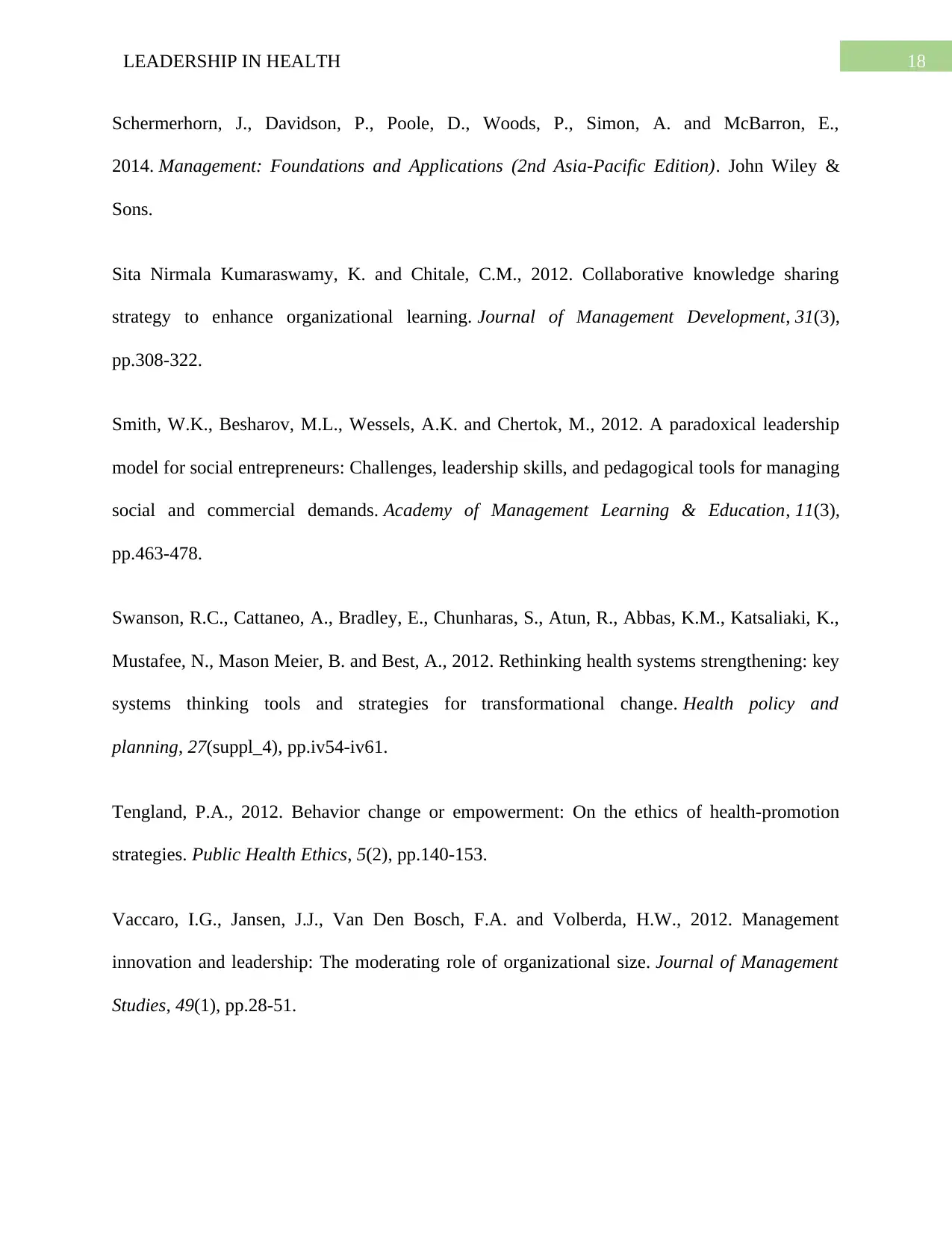
18LEADERSHIP IN HEALTH
Schermerhorn, J., Davidson, P., Poole, D., Woods, P., Simon, A. and McBarron, E.,
2014. Management: Foundations and Applications (2nd Asia-Pacific Edition). John Wiley &
Sons.
Sita Nirmala Kumaraswamy, K. and Chitale, C.M., 2012. Collaborative knowledge sharing
strategy to enhance organizational learning. Journal of Management Development, 31(3),
pp.308-322.
Smith, W.K., Besharov, M.L., Wessels, A.K. and Chertok, M., 2012. A paradoxical leadership
model for social entrepreneurs: Challenges, leadership skills, and pedagogical tools for managing
social and commercial demands. Academy of Management Learning & Education, 11(3),
pp.463-478.
Swanson, R.C., Cattaneo, A., Bradley, E., Chunharas, S., Atun, R., Abbas, K.M., Katsaliaki, K.,
Mustafee, N., Mason Meier, B. and Best, A., 2012. Rethinking health systems strengthening: key
systems thinking tools and strategies for transformational change. Health policy and
planning, 27(suppl_4), pp.iv54-iv61.
Tengland, P.A., 2012. Behavior change or empowerment: On the ethics of health-promotion
strategies. Public Health Ethics, 5(2), pp.140-153.
Vaccaro, I.G., Jansen, J.J., Van Den Bosch, F.A. and Volberda, H.W., 2012. Management
innovation and leadership: The moderating role of organizational size. Journal of Management
Studies, 49(1), pp.28-51.
Schermerhorn, J., Davidson, P., Poole, D., Woods, P., Simon, A. and McBarron, E.,
2014. Management: Foundations and Applications (2nd Asia-Pacific Edition). John Wiley &
Sons.
Sita Nirmala Kumaraswamy, K. and Chitale, C.M., 2012. Collaborative knowledge sharing
strategy to enhance organizational learning. Journal of Management Development, 31(3),
pp.308-322.
Smith, W.K., Besharov, M.L., Wessels, A.K. and Chertok, M., 2012. A paradoxical leadership
model for social entrepreneurs: Challenges, leadership skills, and pedagogical tools for managing
social and commercial demands. Academy of Management Learning & Education, 11(3),
pp.463-478.
Swanson, R.C., Cattaneo, A., Bradley, E., Chunharas, S., Atun, R., Abbas, K.M., Katsaliaki, K.,
Mustafee, N., Mason Meier, B. and Best, A., 2012. Rethinking health systems strengthening: key
systems thinking tools and strategies for transformational change. Health policy and
planning, 27(suppl_4), pp.iv54-iv61.
Tengland, P.A., 2012. Behavior change or empowerment: On the ethics of health-promotion
strategies. Public Health Ethics, 5(2), pp.140-153.
Vaccaro, I.G., Jansen, J.J., Van Den Bosch, F.A. and Volberda, H.W., 2012. Management
innovation and leadership: The moderating role of organizational size. Journal of Management
Studies, 49(1), pp.28-51.
Paraphrase This Document
Need a fresh take? Get an instant paraphrase of this document with our AI Paraphraser
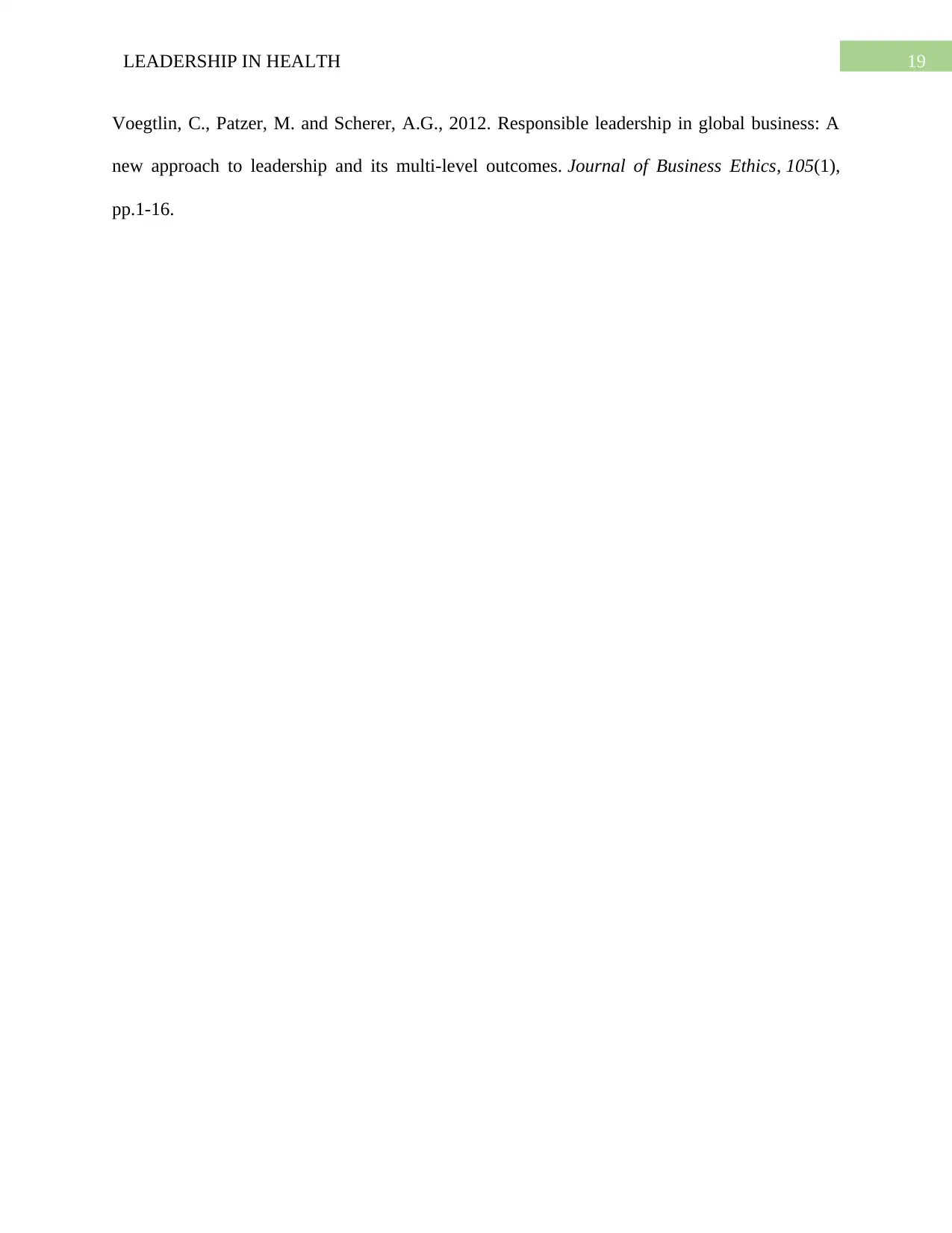
19LEADERSHIP IN HEALTH
Voegtlin, C., Patzer, M. and Scherer, A.G., 2012. Responsible leadership in global business: A
new approach to leadership and its multi-level outcomes. Journal of Business Ethics, 105(1),
pp.1-16.
Voegtlin, C., Patzer, M. and Scherer, A.G., 2012. Responsible leadership in global business: A
new approach to leadership and its multi-level outcomes. Journal of Business Ethics, 105(1),
pp.1-16.
1 out of 20
Related Documents
Your All-in-One AI-Powered Toolkit for Academic Success.
+13062052269
info@desklib.com
Available 24*7 on WhatsApp / Email
![[object Object]](/_next/static/media/star-bottom.7253800d.svg)
Unlock your academic potential
© 2024 | Zucol Services PVT LTD | All rights reserved.





